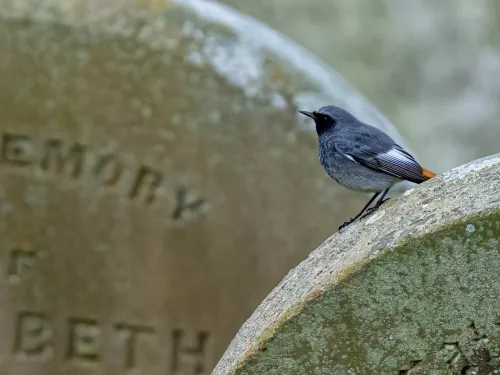
Black redstart
A rare breeder in the UK, this sooty-coloured bird is as at home on an industrial site as it is on a rocky cliff face.

The green spaces of our towns and gardens bring nature into our daily lives, brightening our mornings with birdsong and the busy buzzing of bees. Together, the UK's gardens are larger than all of our National Nature Reserves combined, making them as important for wildlife as they are for our own wellbeing.
These green spaces are a lifeline for wildlife, little havens scattered through the desert of urban sprawl and intensively managed farmland. Trees and shrubs shelter miniature mammals and nesting birds, whilst feeders offer a reliable food source no matter how wild the weather is. Even a single window-ledge plant pot can make a difference, providing pollen and nectar for insects straying into the concrete jungle.
Larger parks and gardens can become a wild paradise, home to creatures you would never expect to find so close to home: grass snakes slithering through the undergrowth, foxes frolicking on lawns, and even owls peering out from the gnarled trunks of old trees.
Parks and gardens are as good for us as they are for wildlife. They provide a place where we can relax, breathe in the fresh air and remind ourselves of the beauty of the wild world around us. For people living in the heart of urban areas, they offer an escape into nature that would otherwise be out of reach.
Spending time connecting with nature is proven to reduce stress and improve both our mental and physical health, and the green oases of our parks and gardens offer the perfect opportunity to do this.
Numbers of house sparrows, song thrushes, dunnocks and starlings have all declined in the countryside, and are now considered endangered. But you can help them, by providing food and places for them to breed in your garden.
Many mammals that would have once lived in the countryside, have learnt to adapt to our towns and gardens; keep a look out for hedgehogs, foxes and house mice. There are lots of ways you can help mammals in your back garden by creating habitat and food sources.
Our towns and gardens are full of wildlife. Take a look at our ID pages to work out what you might have spotted!
The UK's gardens provide more space for nature than all the National Nature Reserves put together.
They help us look after over 2,300 nature reserves and protect the animals that call them home.

A rare breeder in the UK, this sooty-coloured bird is as at home on an industrial site as it is on a rocky cliff face.

The glow-worm is not actually a worm, but a beetle. Males look like typical beetles, but the nightly glow of a female is unmistakeable - lighting up to attract a mate in the darkness of their grassland habitats. Look for the adults in summer.
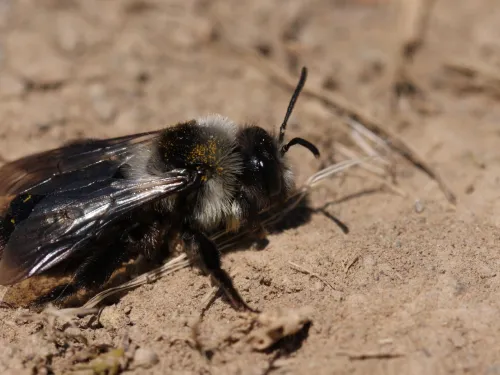
This black and grey solitary bee takes to the wing in spring, when it can be seen buzzing around burrows in open ground.
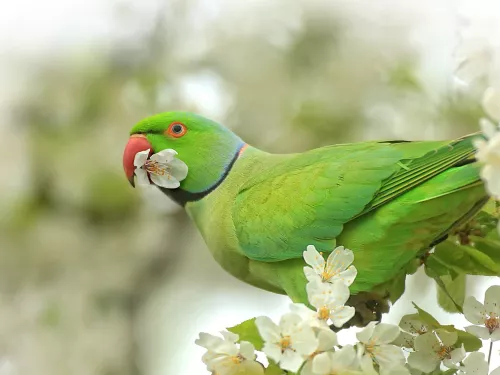
The bright green ring-necked parakeet is an escapee and our only naturalised parrot; its success is likely due to warmer winters. It can be seen in the South East.
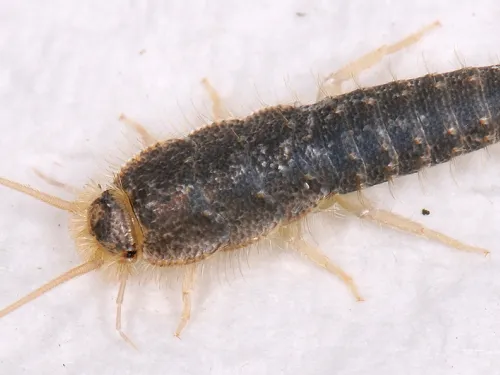
The silverfish is so-named for its fish-like way of moving and its silvery scales. It can be found in the damp corners of the house, such as the kitchen or bathroom. Infestations can cause serious damage.
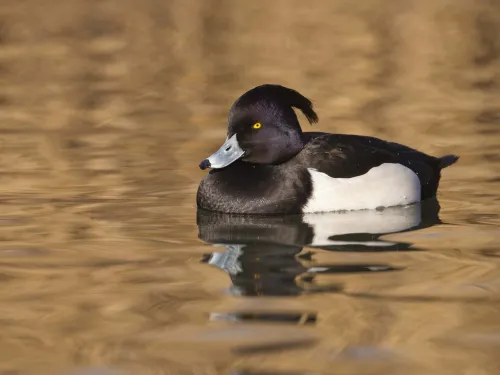
This comical little duck lives up to its name – look out for the black tuft of feathers on its head!

Spot these tall, prehistoric looking birds standing like a statue on the edge of ponds and lakes, contemplating their next meal.
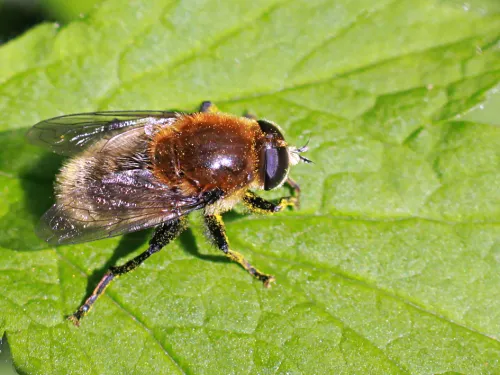
With ginger hairs, dark banding and a cream tail, the Narcissus bulb fly looks like a bumble bee, but is harmless to us. This mimicry helps to protect it from predators while it searches for nectar in gardens.
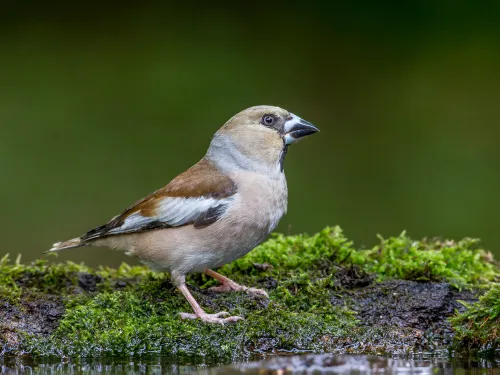
The hawfinch is the UK's largest finch, with an enormous bill powerful enough to crush a cherry stone. Despite their size, they are typically elusive, especially during the summer nesting season.
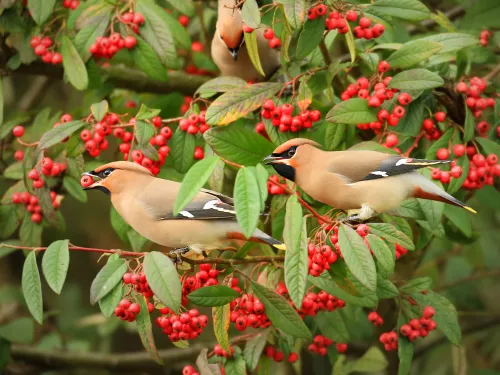
The waxwing is a colourful winter visitor. It can often be spotted in large flocks in berry-laden bushes in towns, car parks and gardens.
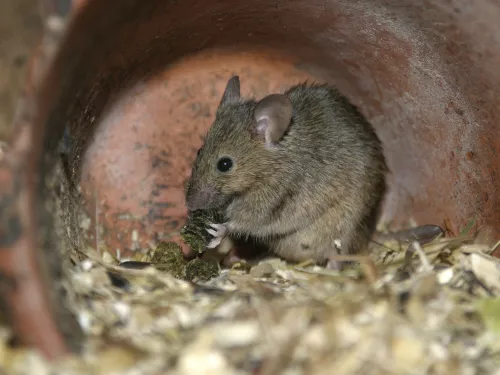
The tiny, grey-brown house mouse is one of our most successful mammals. It thrives around buildings but is less likely to be found in our houses these days due to better construction.
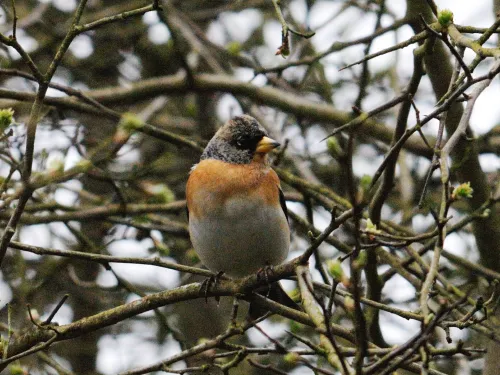
These winter visitors are close relatives of the chaffinch and can often be found in the same flocks, where their white rump and nasal calls give them away.

A notoriously poisonous plant, hemlock produces umbrella-like clusters of white flowers in summer. It can be found in damp places, such as ditches, riverbanks and waste ground.
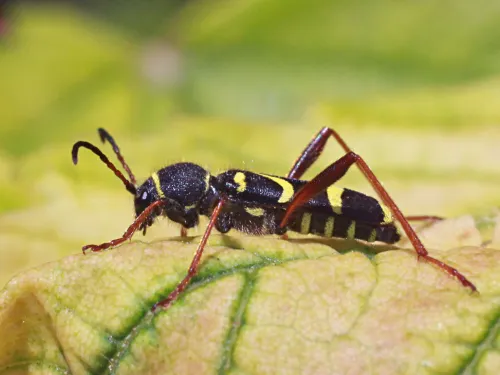
A clever mimic, the wasp beetle is black-and-yellow and moves in a jerky, flight-like fashion - fooling predators into thinking it is actually a more harmful common wasp. Look for it in hedgerows and woods in summer.
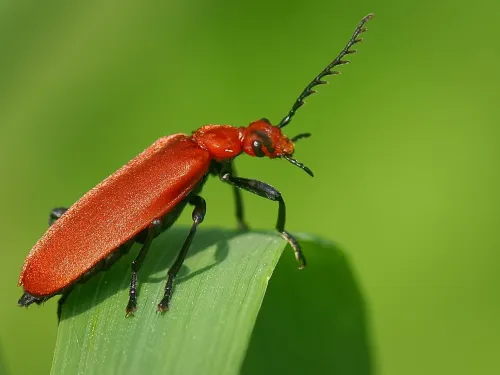
A bright red beetle, with black legs and knobbly antennae, the red-headed cardinal beetle lives up to its name. Look for it in woodland, along hedgerows and in parks and gardens over summer.
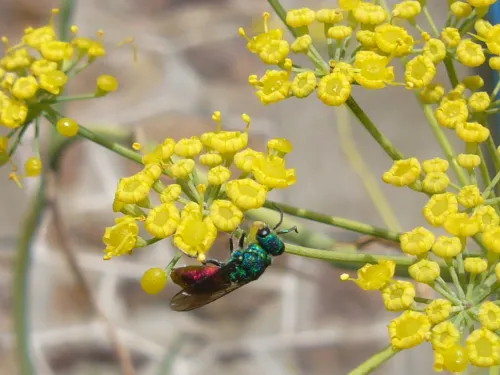
If seen up close, the glittering Ruby-tailed wasp is, perhaps, one of the UK's most beautiful insects. A solitary wasp, it can be found in sandy and rocky habitats like quarries, outcrops and walls.
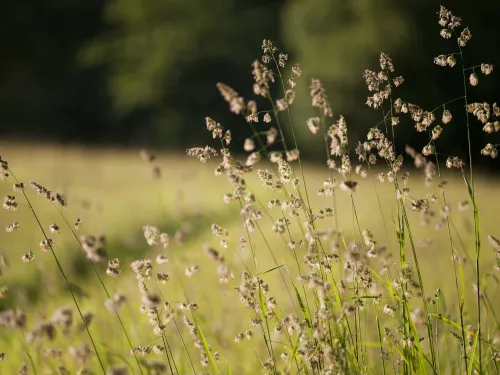
Cock's-foot is a common, tussocky grass of grasslands, woodland rides and cultivated ground - its fluffy, pinky-beige flower heads are quite distinctive.
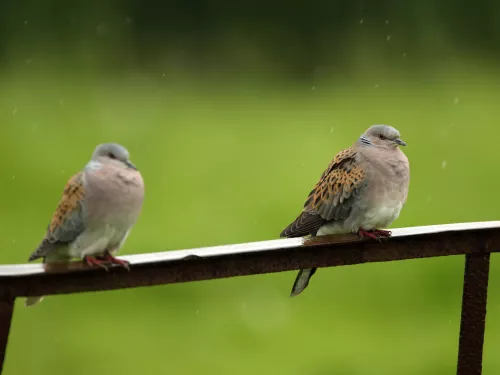
The turtle dove is the UK's fastest declining bird species and is on the brink of extinction. A small and pretty pigeon, it breeds in lowland England and winters in Sub-Saharan Africa.
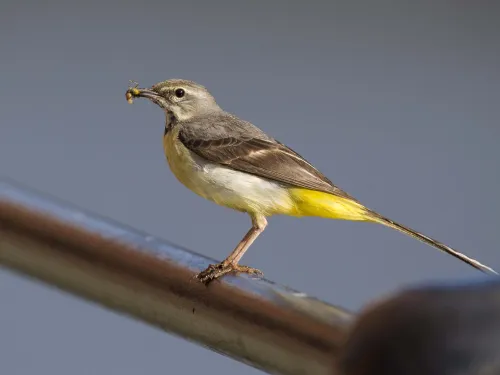
A breeding bird of fast-flowing, upland rivers, the grey wagtail can also be seen in lowland areas, farmyards and even towns in winter.
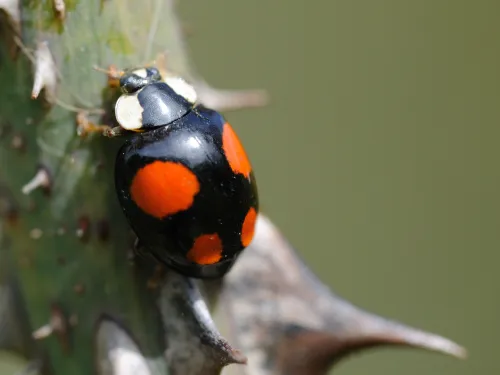
A non-native species originating from Asia, the harlequin ladybird is prevalent in towns and gardens.
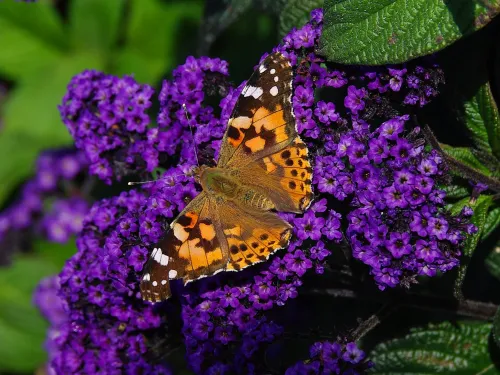
A well-travelled migrant, the painted lady arrives here every summer from Europe and Africa. This beautiful orange-and-black butterfly regularly visits gardens.
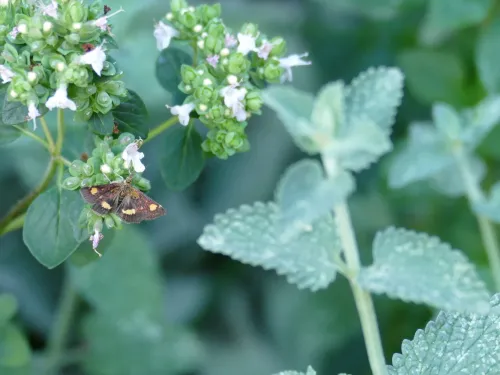
A small, day-flying moth that can often be seen visiting garden herbs.
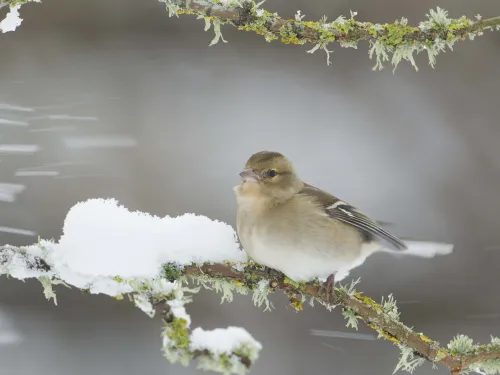
The colourful and delightful chaffinch is a regular garden visitor across the UK. Look out for it hopping about on the ground under birdtables and hedges.
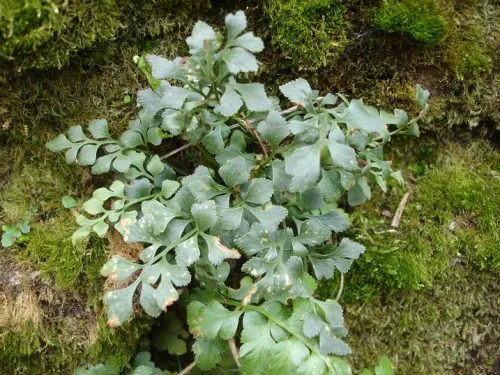
With club-shaped leaflets on its fronds, wall-rue is easy to spot as it grows out of crevices in walls. Plant it in your garden rockery to provide cover for insects.
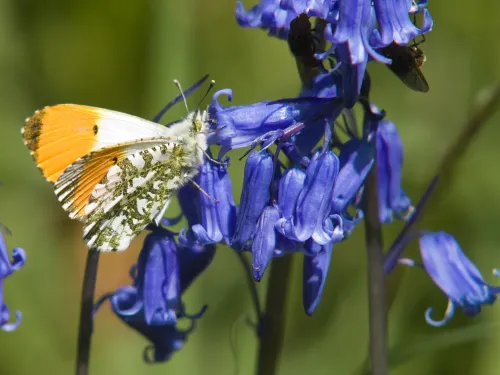
It’s easy to see where these butterflies get their name – the males have bright orange tips on their wings! See them from early spring through to summer in meadows, woodland and hedges.
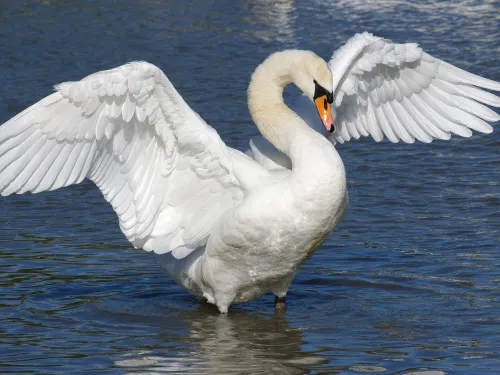
One of our most iconic waterbirds, the mute swan is famed for its grace and beauty. It is also considered to be a romantic of the bird world because partners form a perfect love heart with their necks.
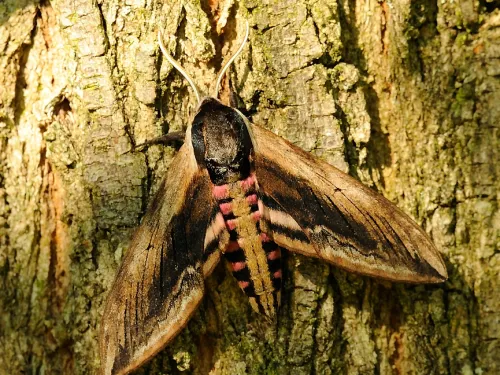
With a torpedo-shaped body and long, narrow wings, the privet hawk-moth is a striking garden visitor. But the caterpillars really stand out: lime-green, with purple streaks and a black hook at the tail end.
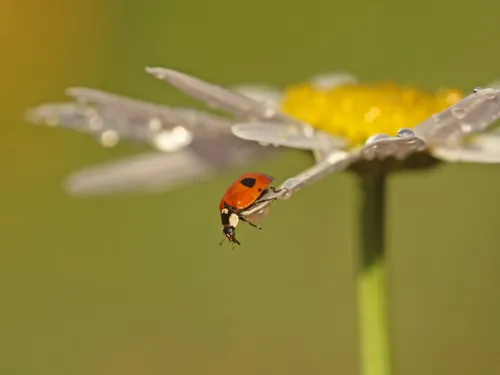
Our most common ladybird, the black-on-red markings of the 2-spot Ladybird are familiar to many of us. Ladybirds are beneficial insects, managing garden pests - encourage them by putting up a bug box.

The St Mark's fly is small, black and shiny. It is so-called because it emerges around St Mark's Day, April 25th. Large numbers of adults can be found in woodland edges, hedgerows, fields and wetlands.

The shoulders of the Forest bug are distinctive - they are square-cut, almost rounded, unlike the other 'spiked' shield bugs. This bug can be found in woodlands, feeding on the sap of oak trees.

The large eyed ladybird is unmistakeable: it is our only ladybird with yellow rings around its black spots. Ladybirds are beneficial insects, managing garden pests - encourage them by putting up a bug box.
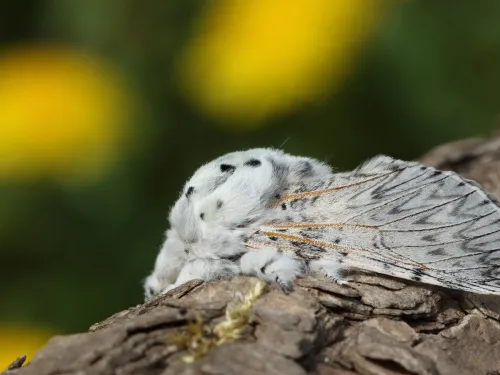
The puss moth is a large and fluffy moth, with a very strange looking caterpillar.

As its name suggests, the smooth stems of soft rush are thinner and more flexible than those of hard rush. It forms tufts in wetland habitats like wet woodlands, marshes, ditches and grasslands.
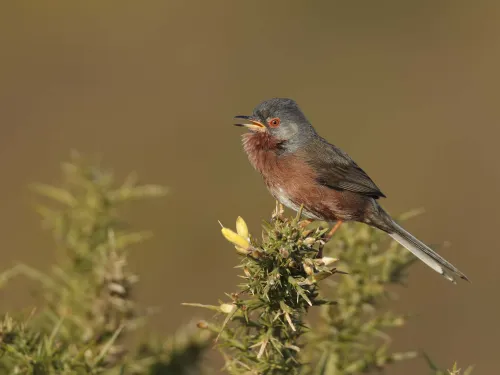
The small, brown Dartford warbler is most easily spotted when warbling its scratchy song from the top of a gorse stem. It lives on lowland heathland in the south of England, where it nests on the ground.
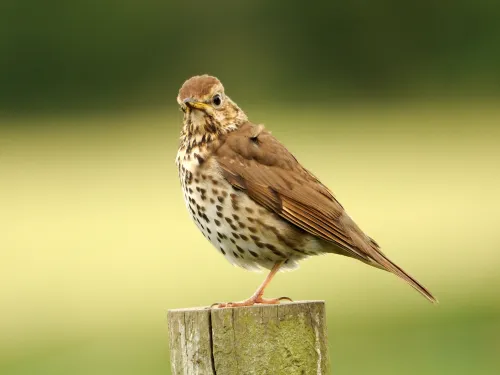
The song thrush is a familiar garden visitor that has a beautiful and loud song. The broken shells of their blue, spotty eggs can often be found under a hedge in spring.
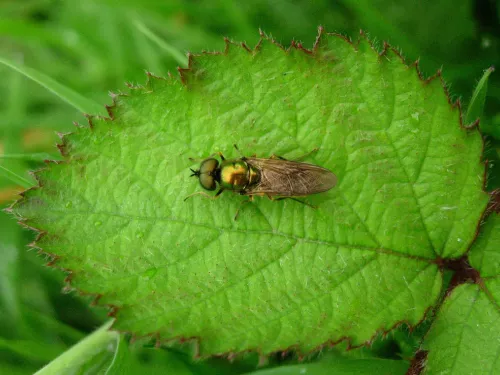
The Broad centurion, or 'Green soldier fly', is one of our most common soldier flies, and is often found in gardens. It has hairy eyes and a metallic blue or bronze body. It is an important pollinator.
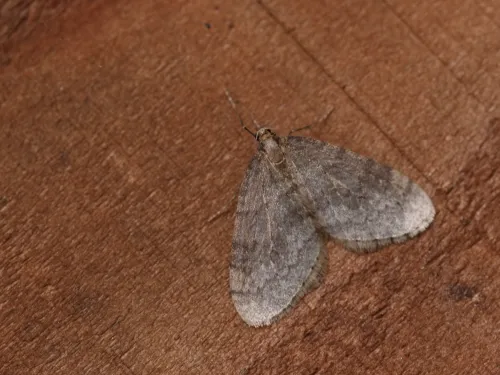
One of the few moths that fly in winter, often seen in car headlights.
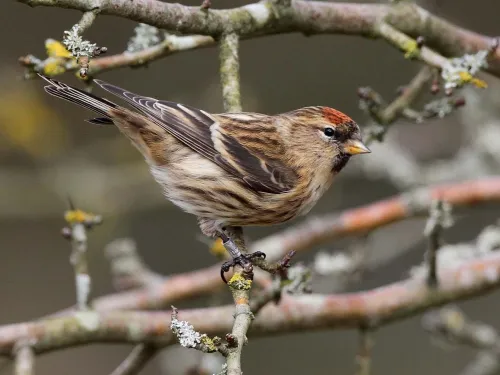
Traditionally a small finch of woodland and scrub, it appears that the lesser redpoll is now moving into our gardens. It has a streaky brown body, red forehead and black bib, and mostly feeds on seeds.
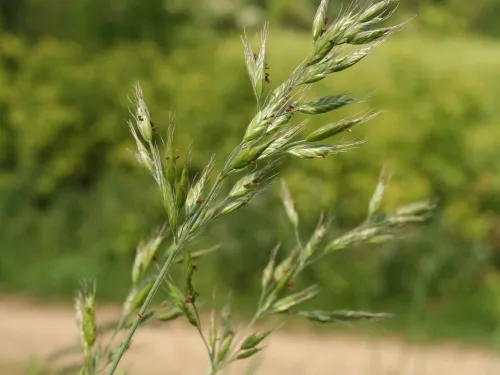
Soft brome is a tall, annual grass of roadside verges, waste ground and meadows, and is a 'weed' of arable land. It has long, grey-green leaves and loosely clustered flower spikes.
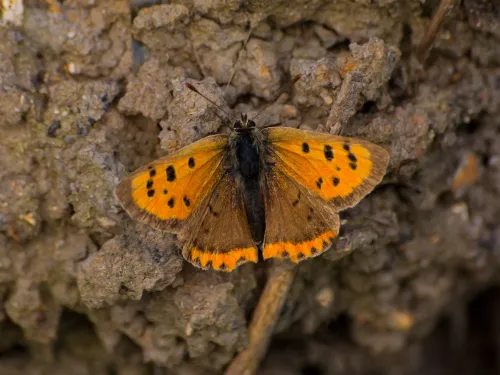
The small copper lives up to its name in both colour and size! Look out for it from April onwards in dry, sunny habitats like heathland, downland and woodland. It can be spotted in gardens, too.
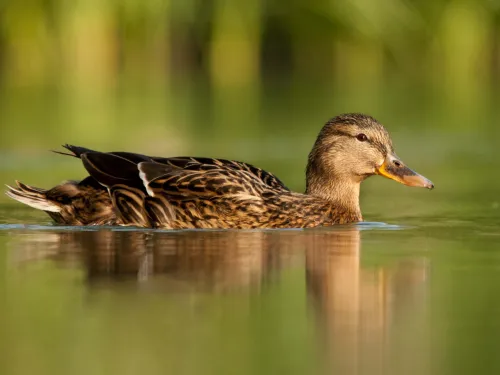
The much-loved mallard is our most familiar duck, found across town and country. If your feeding the ducks please don't feed them bread - it's not good for them! Instead, they love eating sweetcorn, lettuce, oats and seeds.
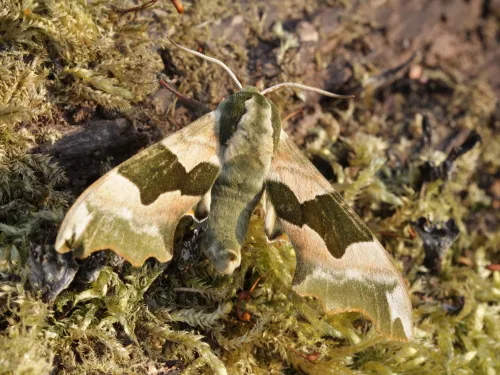
The lime hawk-moth is a large, night-flying moth that can be seen from May to July in gardens, parks and woods. It is buff-coloured, with green patches on its scalloped-edged wings.

A regular in gardens, hunting around compost heaps and under stones, the brown centipede is a common minibeast. Despite its name, it has 15 pairs of legs - one on each segment of its body.
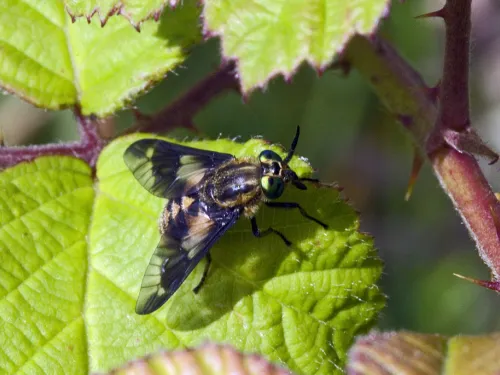
Many of us have felt the painful bite of the Twin-lobed deer-fly (a 'horse-fly') while out walking in damp grasses or woods. But mostly, it prefers to feed on the blood of cows and ponies, often becoming a pest.
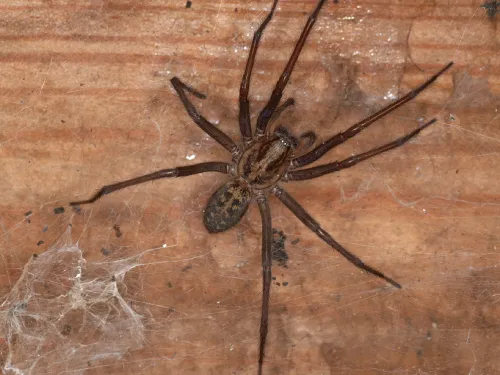
The giant house spider is one of our fastest invertebrates, running up to half a metre per second. This large, brown spider spins sheet-like cobwebs and pops up in the dark corners of houses, particularly in autumn.
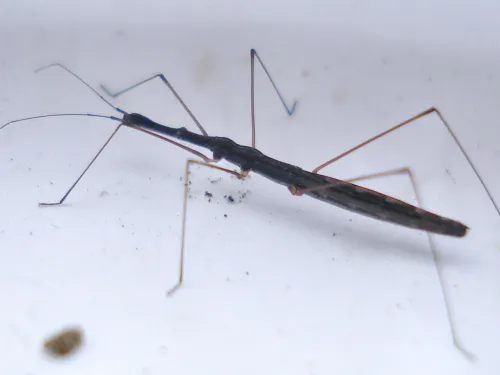
Found in ponds and marshes, the fragile look of the Common water-measurer belies its fierce nature. A predator of small insects, it uses the vibrations of the water's surface to locate its prey.
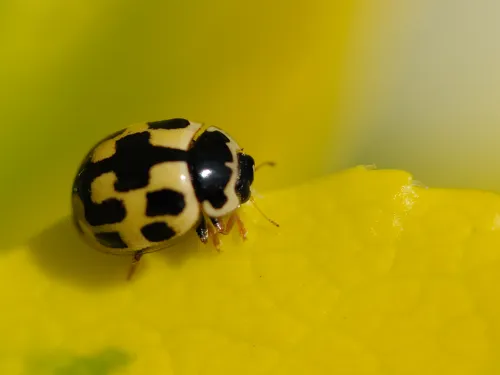
The 14-spot ladybird is one of three yellow ladybirds in the UK. Look for it in grassland, woodland and gardens. Ladybirds are beneficial insects, managing garden pests - encourage them by putting up a bug box.
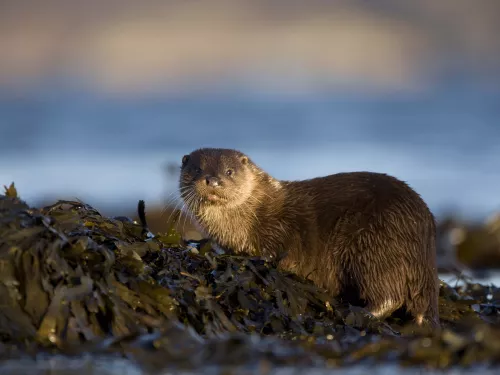
The sinuous otter is an excellent swimmer and can be seen hunting in wetlands, rivers and along the coast - try the west coast of Scotland, West Wales, the West Country or East Anglia for the best views.
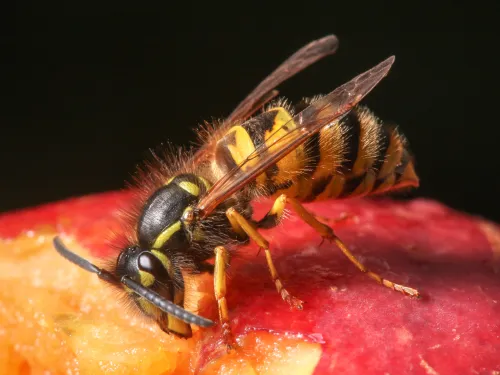
Wasps are well-known, and unfortunately not very well-loved! But give these black and yellow guys a chance, as they are important pollinators and pest controllers.
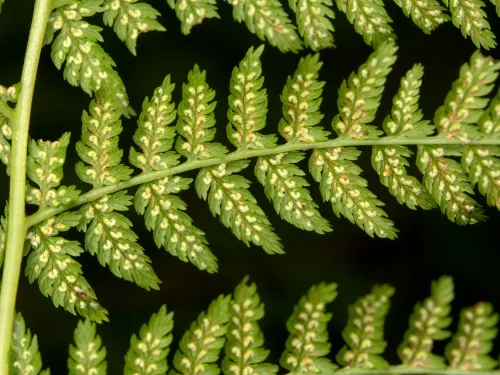
One of the prettiest hardy ferns, the lady fern is delicate and lacy, with ladder-like foliage. It makes a good garden fern, providing attractive cover for wildlife.

This large, fluffy-legged moth is often attracted to lights in May and June.
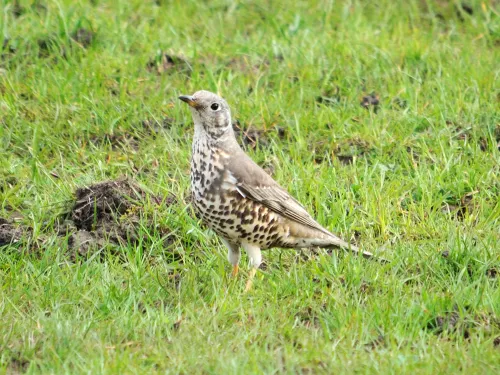
The mistle thrush likely got its name from its love of mistletoe - it will defend a berry-laden tree with extreme ferocity! It is larger and paler than the similar song thrush, standing upright and bold.
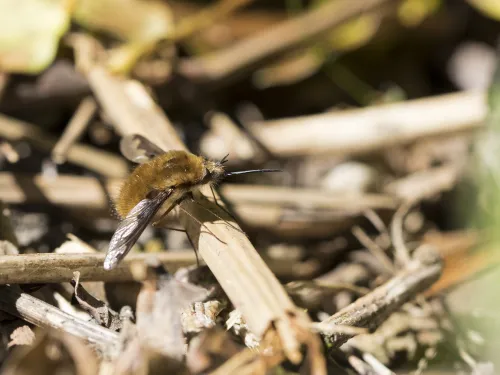
Our largest and most common bee-fly, the dark-edged bee-fly looks just like a bumblebee, and buzzes like one too! It feeds on flowers like primroses and violets in gardens, parks and woodlands.
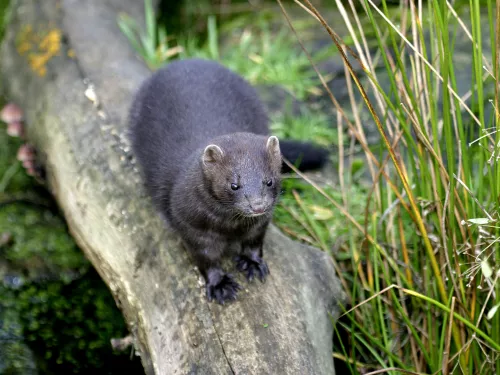
Escaped or intentionally freed from fur farms in the 1960s, the American mink is now well established in the UK. Its carnivorous nature is a threat to our native water vole and seabird populations.
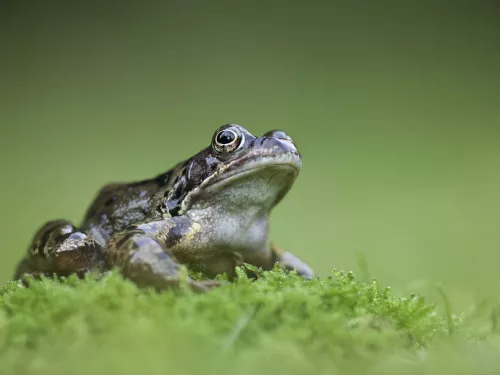
Our most well-known amphibian, the common frog is a regular visitor to garden ponds across the country, where they feast on slugs and snails. In winter, they hibernate in pond mud or under log piles.
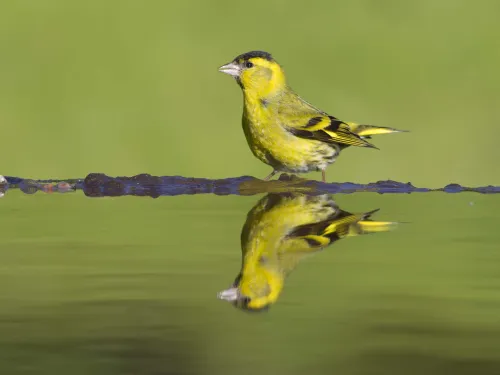
An attractive, green-and-yellow bird, the siskin regularly visits birdtables and feeders in gardens. Look for the bright yellow barring on its black wings, and the black crown of the males.

Field wood-rush is a short rush that forms tufts in grassy places, such as lawns, parks and downlands. A defining characteristic is its leaf-like leaves that are fringed with long, white hairs.
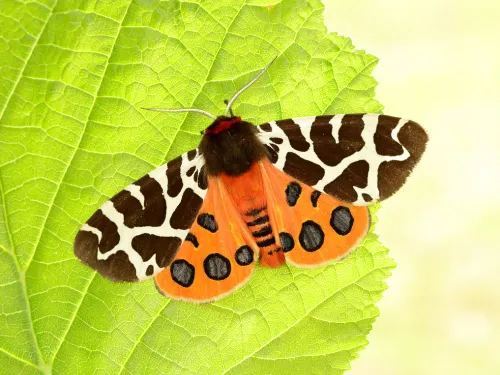
The garden tiger is an attractive, brown-and-white moth of sand dunes, woodland edges, meadows and hedgerows; it will also visit gardens. In decline, it is suffering from the 'tidying up' of our countryside.
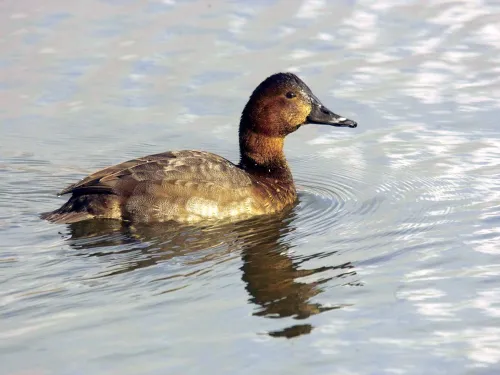
The once-common pochard is now under threat because its populations are declining rapidly. The UK is an important winter destination for the pochard, with 48,000 birds visiting our wetlands and coasts.

Perennial rye-grass is a tufted, vigorous grass of roadside verges, rough pastures and waste ground. It is commonly used in agriculture and for reseeding grasslands.
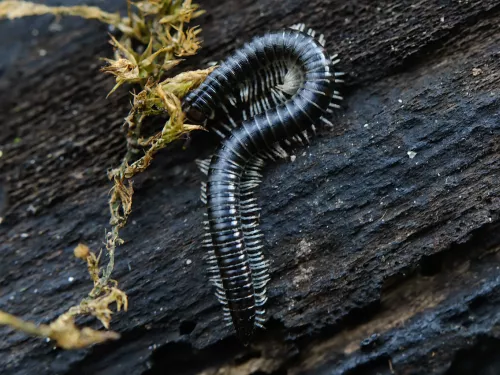
Found in compost heaps and under stones in gardens, the White-legged snake millipede is a common minibeast. Despite its name, it has about 100 legs. It is an important recycler of nutrients, feeding on decaying matter.
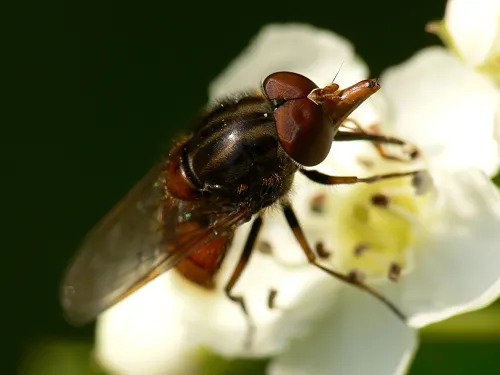
A common hoverfly, the Heineken fly has a distinctively long snout that enables it to take nectar from deeper flowers, reaching the parts other hoverflies cannot reach! It frequents hedgerows, gardens and woods.
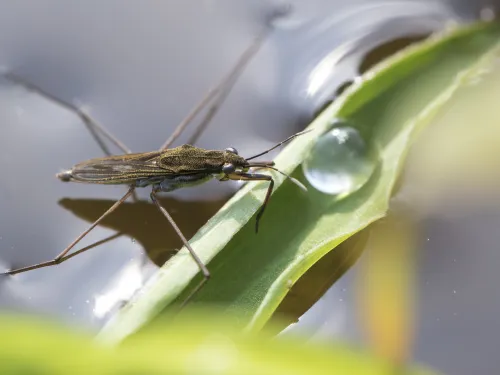
The common pond skater can be seen 'skating' over the surface of ponds, lakes, ditches and slow-moving rivers. It is predatory, feeding on small insects by detecting vibrations in the water's surface.
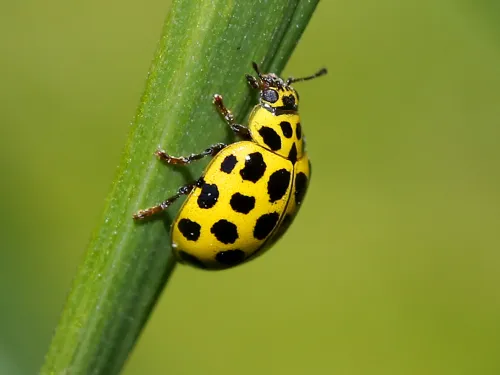
The 22-spot ladybird is one of three yellow ladybirds in the UK. Look for it in grassland, woodland and gardens. Ladybirds are beneficial insects, managing garden pests - encourage them by putting up a bug box.
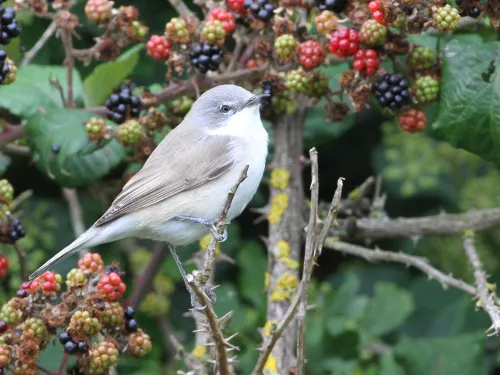
The lesser whitethroat is smaller than its cousin, the whitethroat, and sports dark cheek feathers that give it a 'mask'. Most likely to be heard around woodland and scrub, rather than seen.
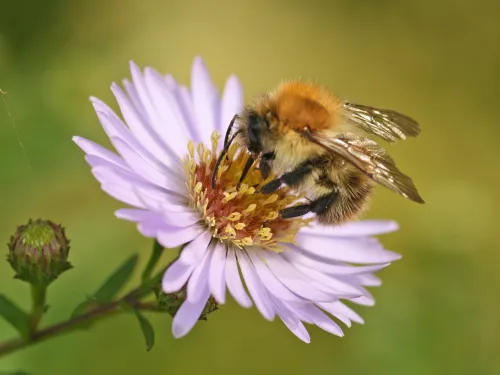
The common carder bee is a fluffy, gingery bumble bee that can often be found in gardens and woods, and on farmland and heaths. It is a social bee, nesting in cavities, old birds' nests and mossy lawns.
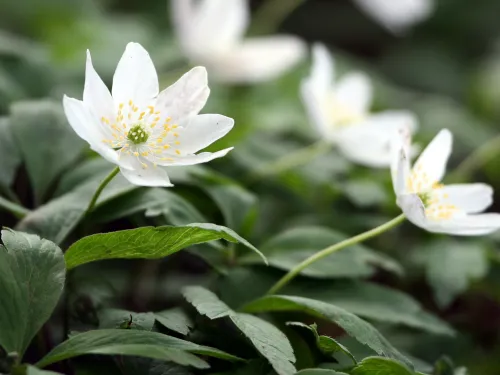
A spring delight, the wood anemone grows in dappled shade in ancient woodlands. Traditional management, such as coppicing, can help such flowers by opening up the woodland floor to sunlight.
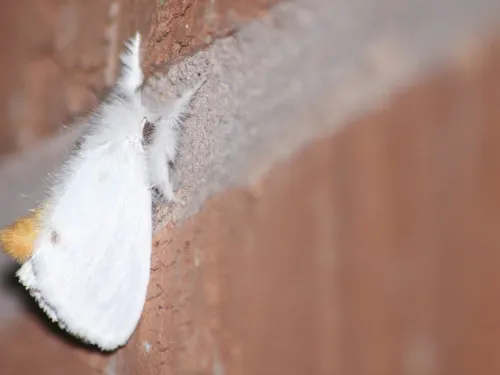
This snowy white moth is easily mistaken for the similar brown-tail, until it lifts its abdomen to reveal a burst of golden-yellow.
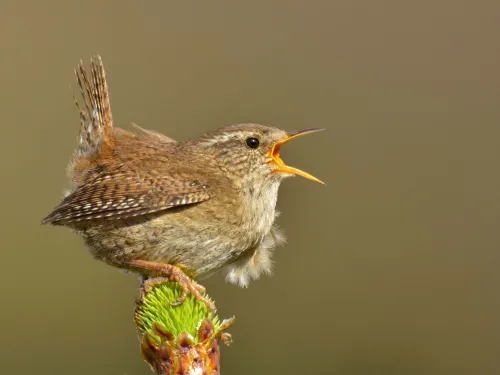
The tiny wren, with its typically cocked tail, is a welcome and common visitor to gardens across town and countryside. It builds its domed nests in sheltered bushes and rock crevices.
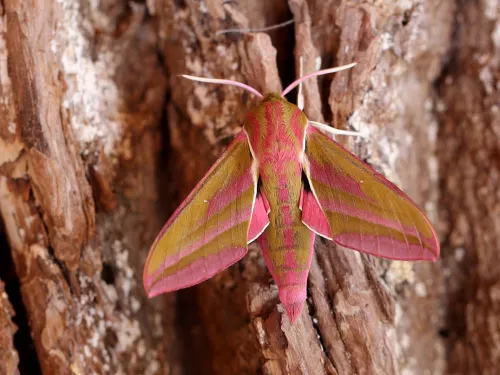
The elephant hawk-moth is a pretty, gold-and-pink moth that can be seen at dusk in gardens, parks, woods and grassy habitats. The caterpillars look like elephant's trunks and have eyespots to scare off predators.
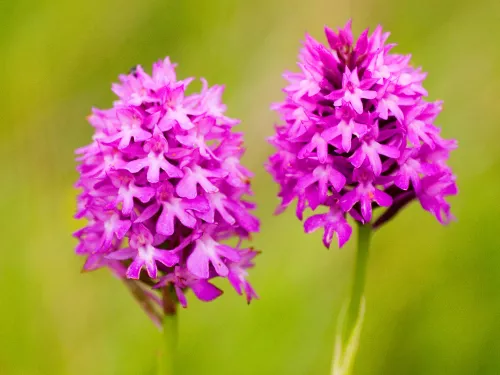
The Pyramidal orchid lives up to its name - look for a bright pinky-purple, densely packed pyramid of flowers atop a green stem. It likes chalk grassland, sand dunes, roadside verges and quarries.
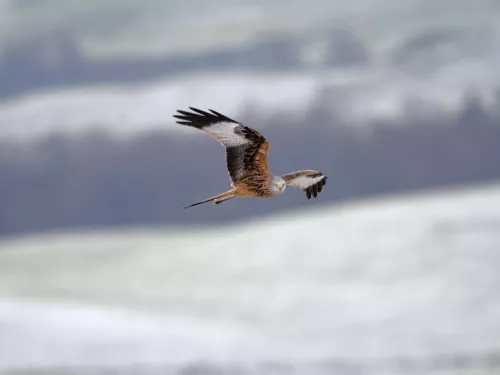
Seeing a red kite soaring high in the sky is a true delight! Once a very rare bird, thanks to successful reintroduction projects these wonderful birds can now be seen in lots of places in the UK.

Like many of our farmland birds, the yellowhammer has declined in number in recent years. Spot this bright yellow bird singing from the top of a bush or fence, or in a mixed-species flock in winter.
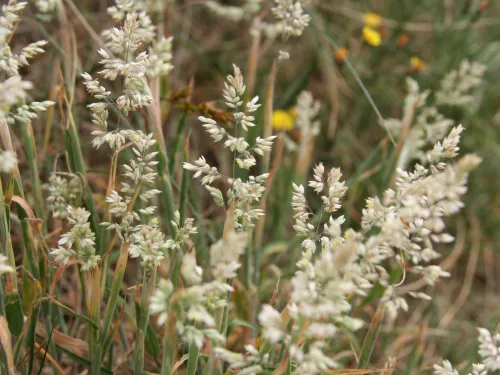
The soft, downy look of Yorkshire-fog makes it an attractive plant, even if it is considered a weed of cultivated land! It is also attractive to the caterpillars of the Small Skipper butterfly as a foodplant.
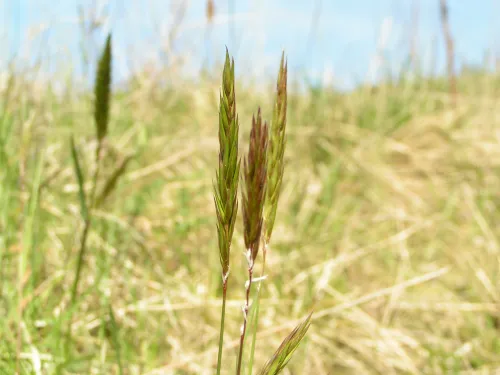
Flowering in spring, the cylindrical, densely packed flower spikes of Sweet vernal-grass are easily spotted in a meadow. It also tastes of sweet vanilla and was once a favourite 'chewing grass'.
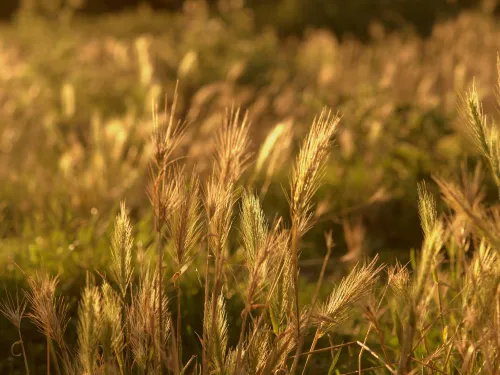
The distinctive spiky, or 'bearded', green flower heads of wall barley appear from June to July and are easy to spot in an urban environment as they push their way up through pavements and walls.
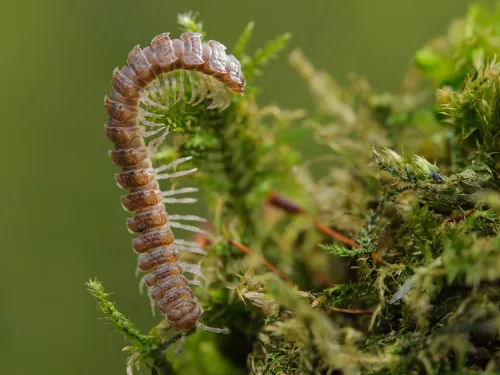
Found in compost heaps and under stones in gardens, the Flat-backed millipede is a common minibeast. Despite its name, it only has about 40 legs. It is an important recycler of nutrients, feeding on decaying matter.
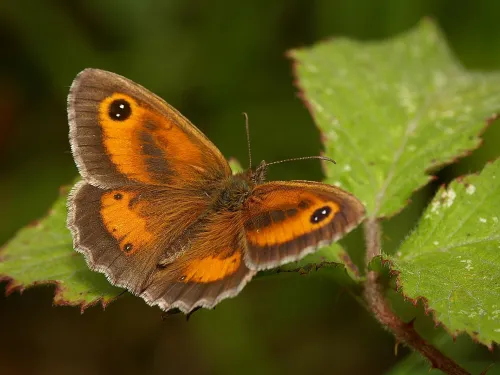
The gatekeeper is on the wing in summer on grasslands, in woodlands and along hedgerows. Look out for the large, distinctive eyespot with two 'pupils' on each forewing.
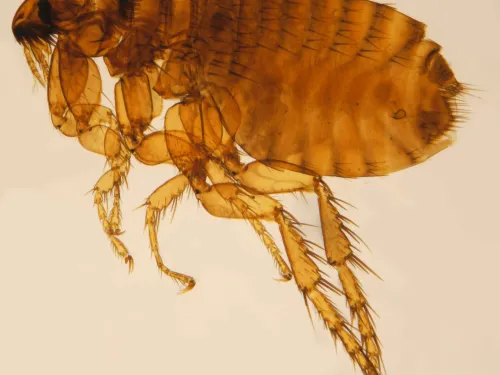
You are most likely to spot the cat flea if you have pets. It will feed on cats, dogs and people, although it can't live on us. It is a pest and needs to be controlled in the house for the comfort of pets and people.

The water scorpion is not a true scorpion, but it certainly looks like one! An underwater predator, it uses its front pincer-like legs to catch its prey. Its tail actually acts as a kind of 'snorkel', rather than a sting, so it can breathe in the water.

The wasp spider is a great mimic - looking just like a common wasp keeps it safe from predators, even though it is not dangerous itself. It can be found in southern England, but is spreading north.
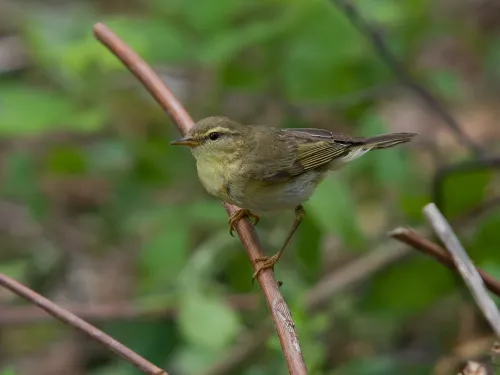
A summer visitor, the willow warbler can be seen in woodland, parks and gardens across the UK. It arrives here in April and leaves for southern Africa in September.
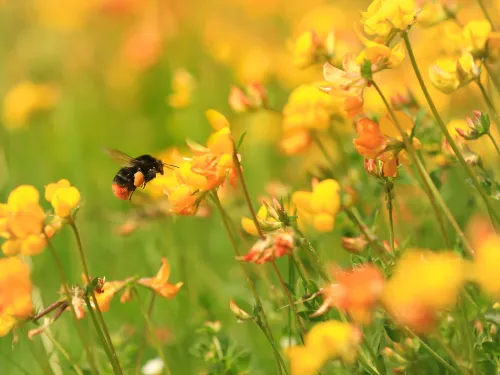
Living up to its name, the red-tailed bumblebee is black with a big, red 'tail'.
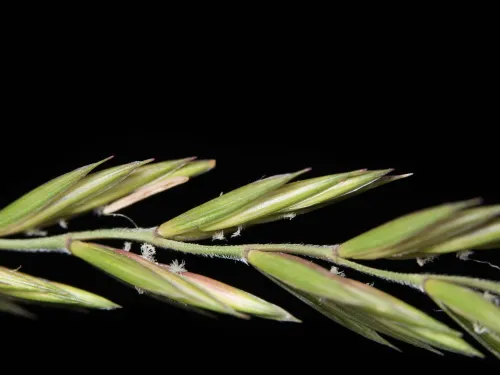
Common couch is a tall, tuft-forming grass of roadside verges, waste ground and arable land. It is very tough and can shade out more delicate plants. Look for flat, blade-like leaves and thin flower spikes.
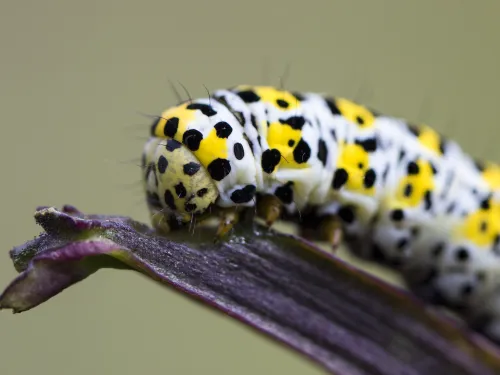
You're more likely to see the attractive, brightly coloured caterpillars than the mullein moth itself.
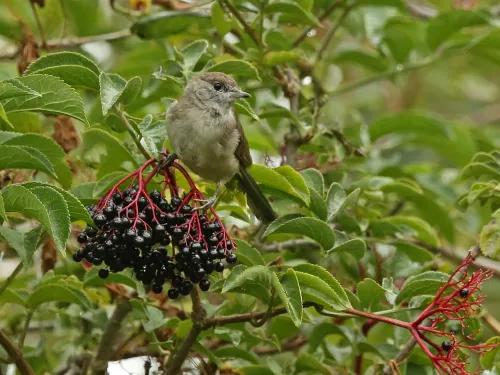
As the name suggests, the male blackcap has a black cap, while the female has a gingery one. Look for this distinctive warbler in woodland, parks and gardens.
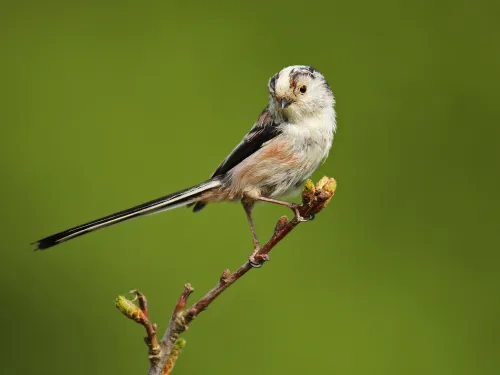
Living up to its name, the long-tailed tit can be easily recognised by its long tail. It is a small, pretty, pink, black and white bird that can be seen in woodlands, gardens and parks.
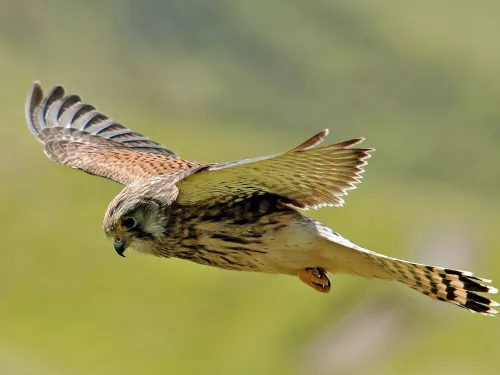
The kestrel is a familiar sight hovering over the side of the road, looking out for its favourite food: small mammals like field voles. It prefers open habitats like grassland, farmland and heathland, but can be seen in towns and villages.

Listen out for the cat-like, 'kee-yaa' calls of the buzzard as it soars high over farmland and woodland. Once suffering from severe persecution and pesticide poisoning, it has made a stunning comeback to most of the UK.
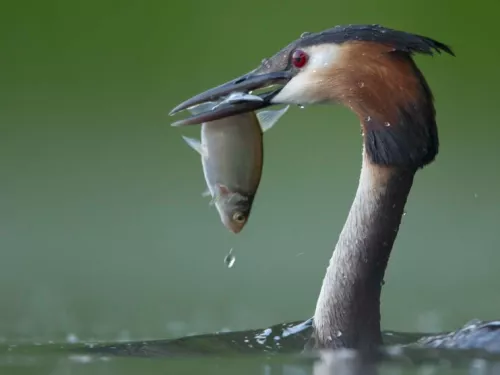
The graceful great crested grebe is a familiar sight on our lakes and reservoirs, and is well-known for its elaborate courtship dance, during which it rises vertically out of the water and shakes its head.

If you have a garden pond, look out for the Large red damselfly resting at the water's edge. As the name suggests, males are bright red with a black thorax, but females may be almost entirely black.
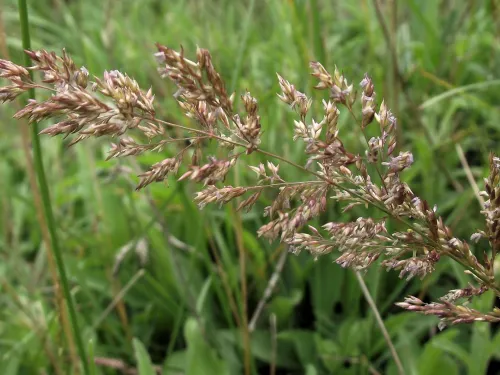
As its name suggests, creeping bent runs along the ground before it bends and grows upright. It is a common grass of arable land, waste ground and grasslands.
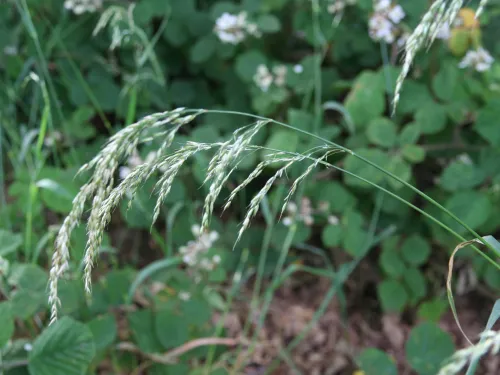
A fluffy-looking grass of rough grassland, roadside verges and disturbed ground, False oat-grass is very familiar and often overlooked; in fact, it can help to stabilise dunes and shelter small mammals.
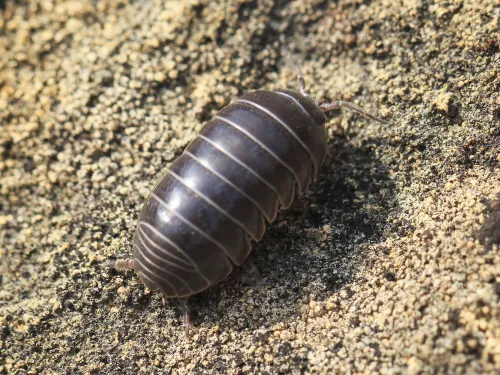
The defensive mechanism of the pill woodlouse is very recognisable - it curls itself into a tight ball, only showing its plated armour to its attacker. It is an important recycler of nutrients, feeding on decaying matter.

The stiff, spiky and upright leaves and brown flowers of hard rush are a familiar sight of wetlands, riversides, dune slacks and marshes across England and Wales.
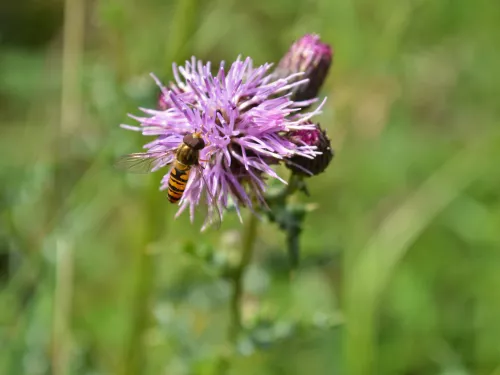
Our most common hoverfly, the marmalade fly is orange with black bands across its body. It feeds on flowers like tansy, ragwort and cow parsley in gardens, hedgerows, parks and woodlands.
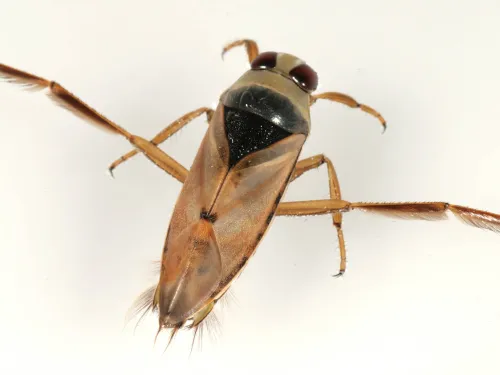
The fearsome common backswimmer hunts insects, tadpoles and fish. It uses its oar-like legs to swim upside-down under the water's surface where unsuspecting prey can be found.
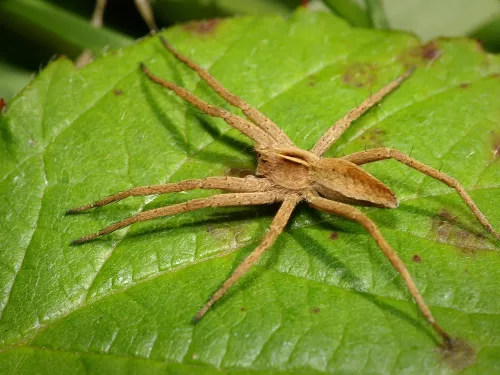
A common spider of heathland and grassland, the Nursery web spider has brown and black stripes running the length of its body. It is an active hunter, only using its silk to create a protective tent for its young.
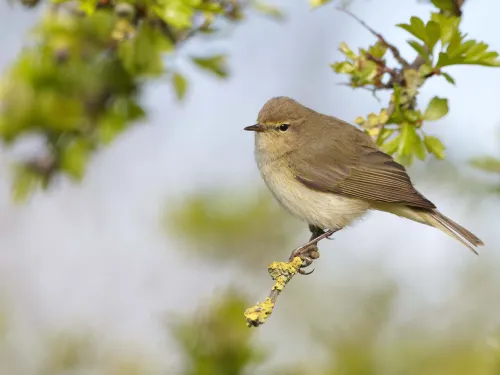
In early spring, listen out for the 'chiff chaff chiff chaff' song of the appropriately named chiffchaff. It can be heard in woodland, scrub, parks and gardens across the UK.
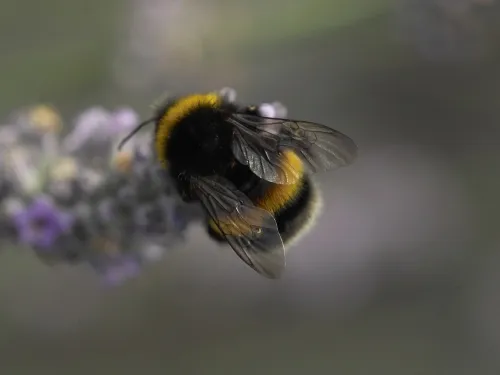
Living up to its name, the white-tailed bumblebee is black-and-yellow bee with a bright white 'tail'. A social bumble bee, it can be found nesting in gardens and woods, and on farmland and heaths.
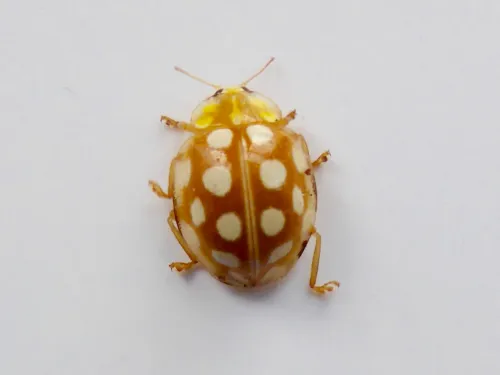
The orange ladybird is pale orange with up to 16 cream spots on its wing cases. It feeds on mildew on trees like sycamore and ash, and hibernates in the leaf litter. It often turns up in moth traps.
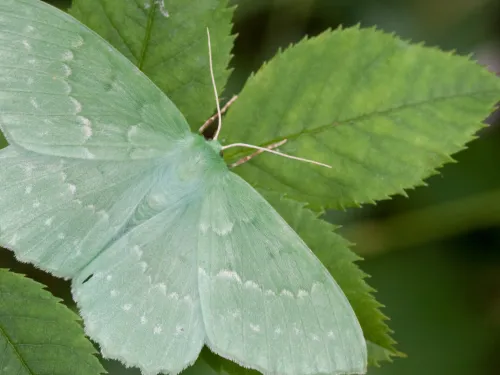
This large green moth rests with its wings spread, so is sometimes mistaken for a butterfly.

The hooded crow was thought to be the same species as the carrion crow, but they have now been separated. Less widespread than its cousin, look for it in North Scotland, Northern Ireland and the Isle of Man.
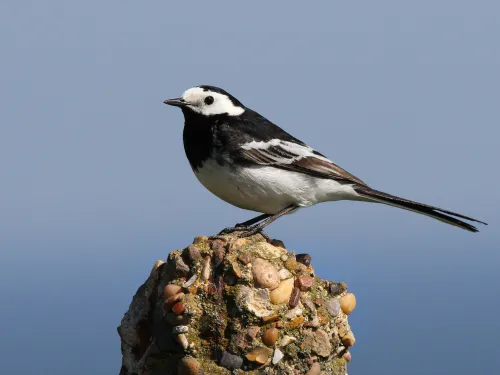
The pied wagtail is a familiar bird across town and countryside. Its black-and-white markings and long, wagging tail make it easy to identify as it hops across the road or lawn.
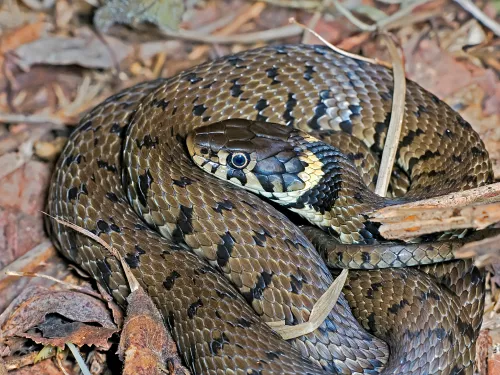
The grass snake is our longest snake, but don't worry if you find one in the compost heap - it's harmless! Look out for this green and yellow beauty in grasslands and wetlands, too.
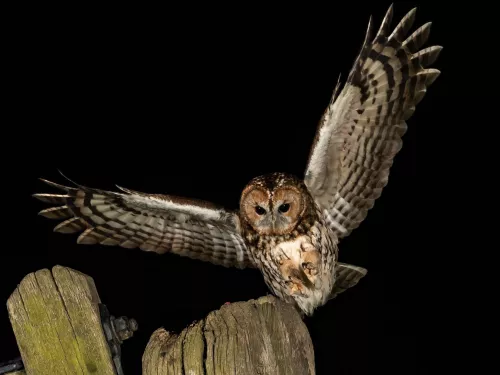
Tawny owls are the familiar brown owls of Britain’s woodlands, parks and gardens. They are known for their ‘too-wit too-woo’ song that can be heard at night-time.
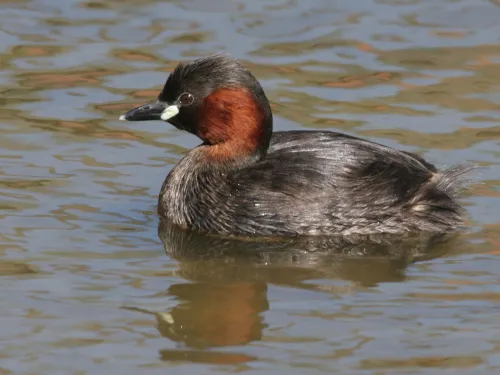
The little grebe is a fantastic diver, but to help it swim underwater, its feet are placed towards the back of its body, making it rather clumsy on land. It only really comes ashore to breed.

The Azure damselfly is a pale blue, small damselfly that is commonly found around most waterbodies from May to September. Try digging a wildlife pond in your garden to attract damselflies and dragonflies.

Timothy is a grass of meadows, arable land, waste ground and roadside verges. It is also cultivated as fodder for livestock. Look for slender stems and long, cylindrical flower spikes in summer.
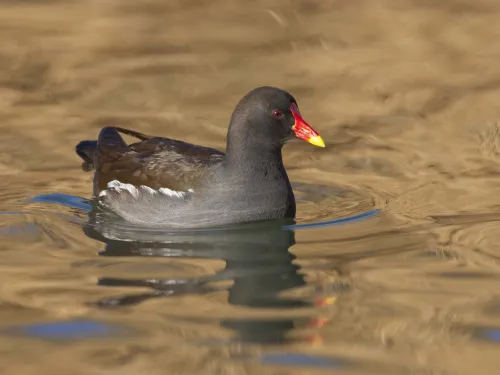
A familiar black bird of our lakes, ponds and rivers, the moorhen is widespread; look out for its large and untidy-looking nest on the water in spring. It can be distinguished from the similar coot by its yellow legs, red beak and the white patches on its body.
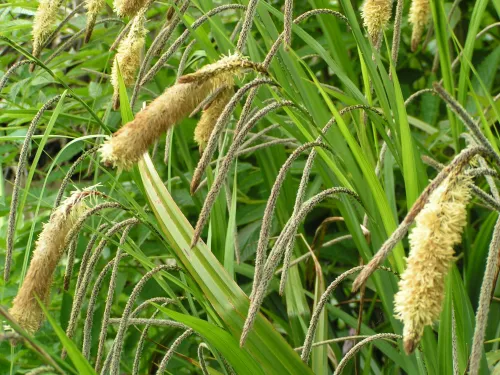
As its name suggests, pendulous sedge has drooping form with long, nodding flower spikes that give it an attractive and soft look. It can be found in wet woodlands and along riversides.
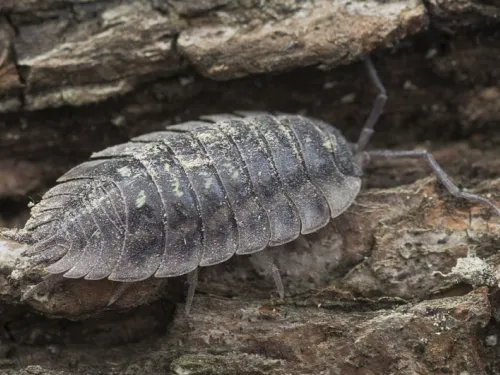
If you were to pick up a rock in the garden, you’d hopefully find a few common woodlouse. These hardy minibeasts have in-built armour and like to hide in warm, moist places like compost heaps.
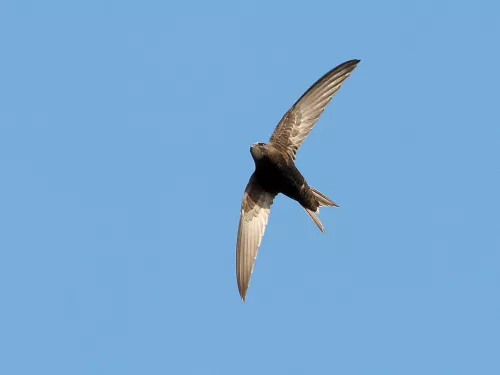
Swifts spend most of their lives flying – even sleeping, eating and drinking – only ever landing to nest. They like to nest in older buildings in small holes in roof spaces.
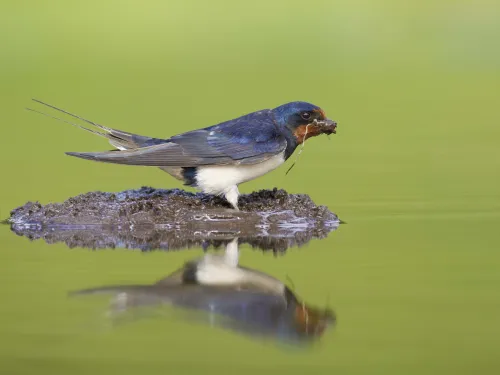
Look out for the swallow performing great aerial feats as it catches its insect-prey on the wing. You may also see it perching on a wire, or roosting in a reedbed, as it makes its way back to Africa for the winter.
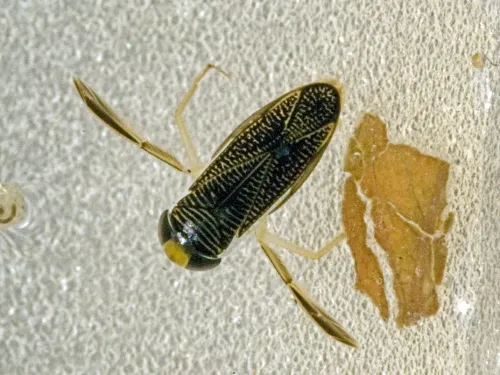
Similar to the Common backswimmer, the Lesser water boatman has oar-like legs to help it swim, but it does not swim upside-down. It is herbivorous and can be found at the surface of ponds, lakes and ditches.
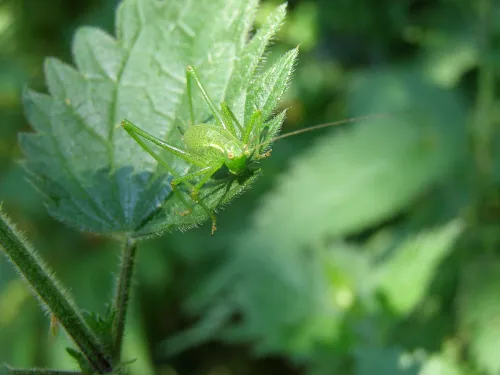
The Speckled bush-cricket, as its name suggests, is covered in tiny, black speckles. It can be found in scrub, hedgerows and gardens throughout summer. Males rub their wings together to create a 'song' for the females.
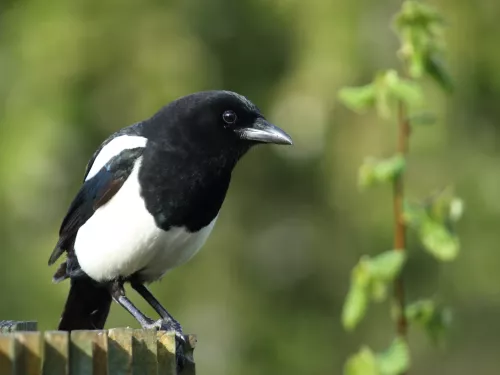
"One for sorrow, two for joy…" is a popular rhyme associated with the magpie - a bird of much myth and legend. An unmistakeable member of the crow family, it can be seen almost anywhere.
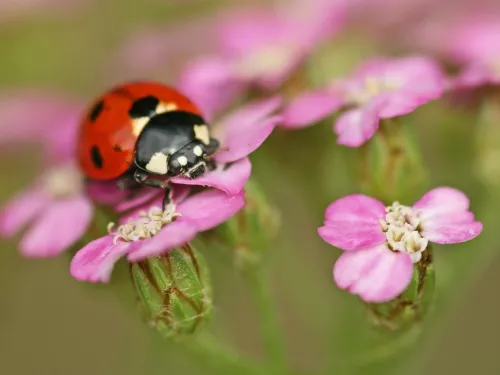
One of our most common ladybirds, the black-on-red markings of the 7-spot ladybird are very familiar. Ladybirds are a gardeners best friend as they eat insects that love to nibble on garden plants! You can encourage them into your garden by putting up a bug box.
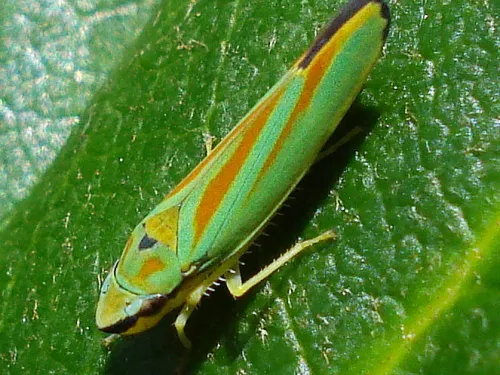
An introduced species, the Rhododendron leafhopper is a striking mix of green and red, with a black stripe across its face. It can be found feeding on Rhododendrons (also introduced) in Southern England.
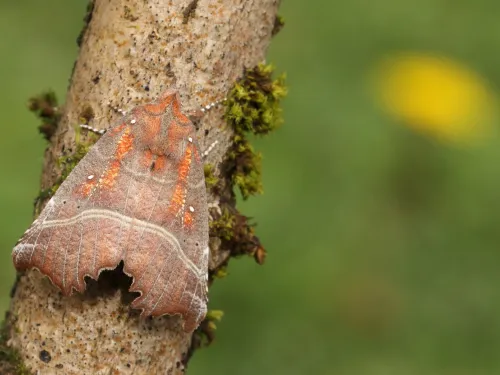
This unmistakable moth spends the winter as an adult, tucked away in a sheltered spot like a cave or outbuilding.
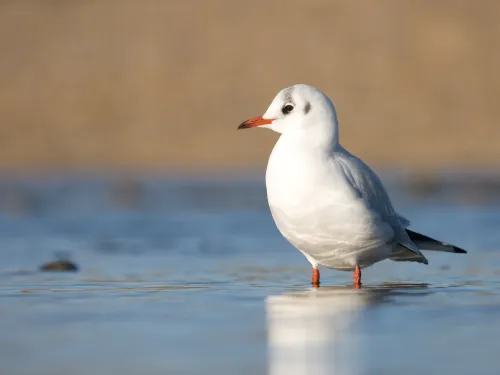
The black-headed gull is actually a chocolate-brown headed gull! And for much of the year, its head even turns white. Look out for it in large, noisy flocks on a variety of habitats.
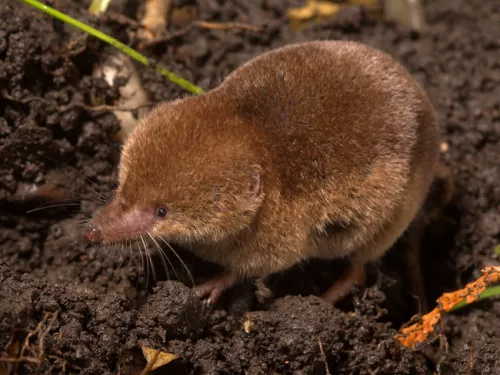
The diminutive common shrew has a distinctively pointy nose and tiny eyes. It lives life in the fast lane, eating every 2-3 hours to survive, and only living for a year or so. Look out for it in the garden.
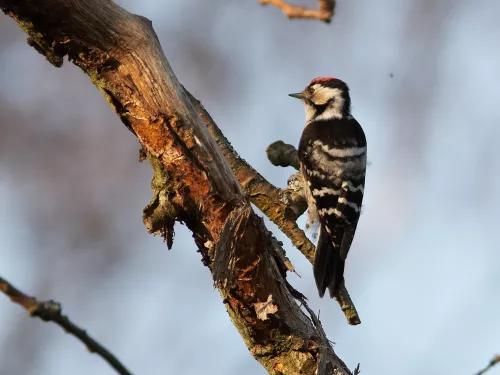
The lesser spotted woodpecker is the smallest of the UK's woodpeckers. Listen out for its drumming, which is quieter than that of the great spotted woodpecker, in woodland, parks , orchards and gardens.
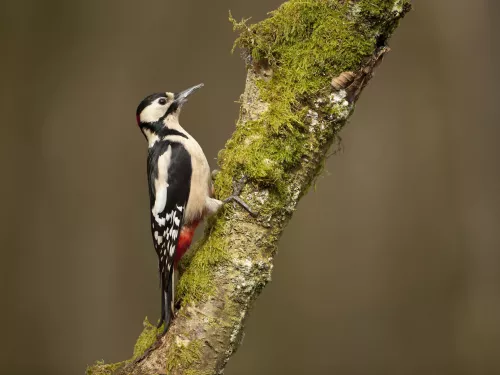
The 'drumming' of a great spotted woodpecker is a familiar sound of our woodlands, parks and gardens. It is a form of communication and is mostly used to mark territories and to display in spring.

The cormorant is an excellent fisher. It is most easily spotted when it is perched, stretching its wings out in the sun to dry after a dive. The UK holds internationally important wintering numbers of cormorant.

Living up to its name the Common blue damselfly is both very common and very blue. It regularly visits gardens - try digging a wildlife-friendly pond to attract damselflies and dragonflies.
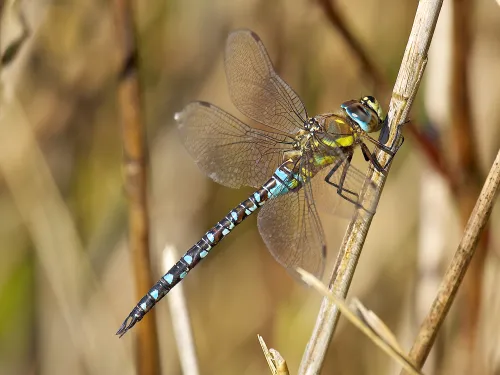
The Migrant hawker is not a particularly aggressive species, and may be seen feeding in large groups. It flies late into autumn and can be seen in gardens, grasslands and woodlands.
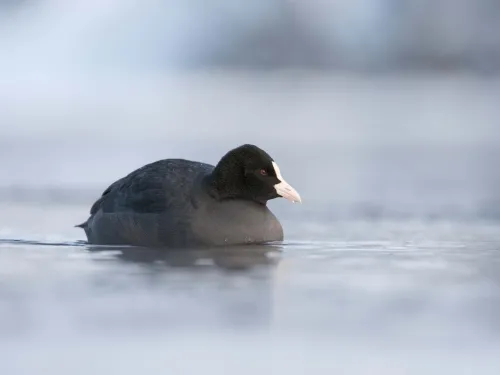
A familiar black bird of our lakes, ponds and rivers, the coot is widespread; look out for its large and untidy-looking nest on the water in spring. The coot can be distinguished from the similar Moorhen by its white beak and 'shield', and its entirely black body.
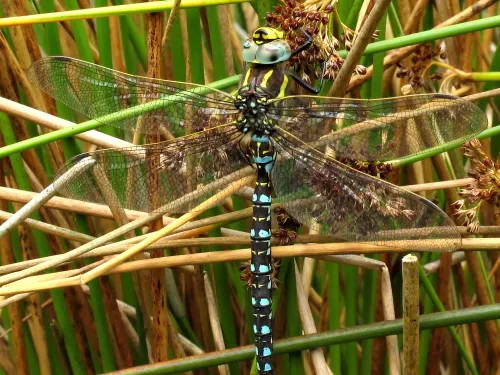
A large hawker, the Common Hawker can be seen throughout the summer and into autumn. A fast-flying insect, it catches its prey mid-air. Look for it around ponds in the uplands of the north and west.
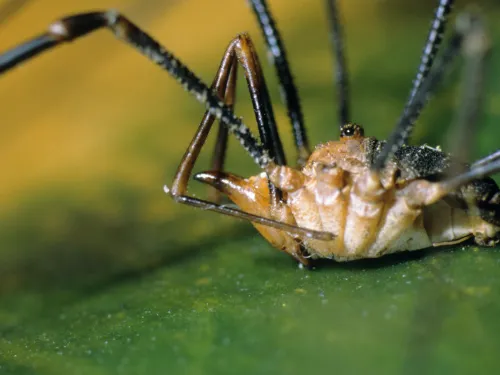
The Common harvestman is familiar to us as the large, spindly spider-like creature that frequents gardens and houses. It predates on smaller invertebrates which it catches using hooks on the ends of its legs.
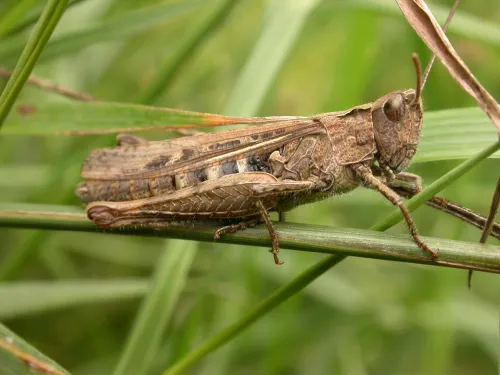
The Common field grasshopper can be found in sunny, grassy areas, particularly gardens, throughout summer. Males can be seen rubbing their legs against their wings to create a 'song' for the females.
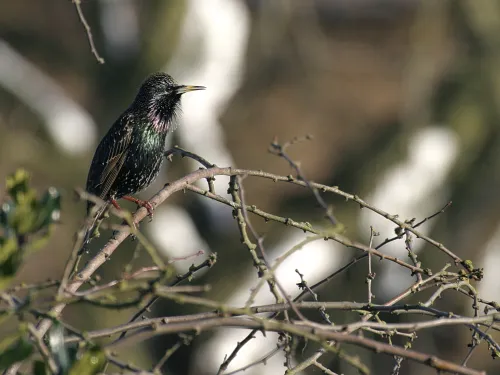
The starling is a familiar garden visitor that has a beautiful purple-and-green sheen to its black feathers. It is famous for its wintry aerial displays - massive flocks can be seen wheeling over our towns and farmland.
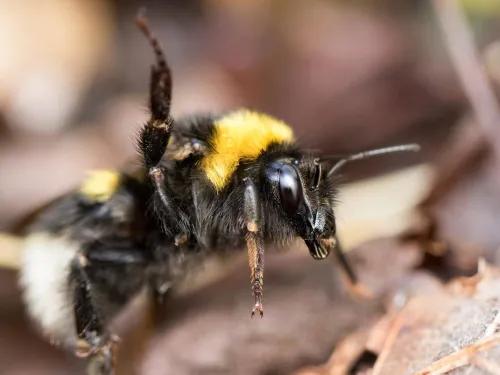
Unsurprisingly, the garden bumblebee can be found in the garden, buzzing around flowers like foxgloves, cowslips and red clover. It is quite a large, scruffy-looking bee, with a white tail. It nests in colonies.
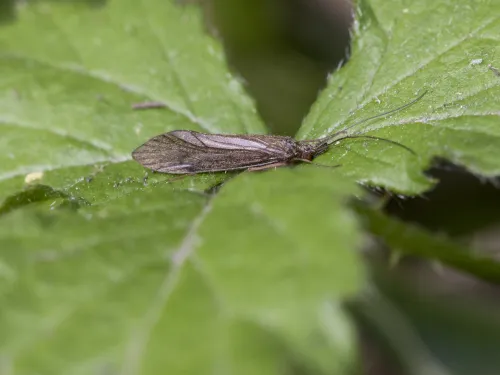
Caddisflies are a large order of insects that can be found in all kinds of wetlands. The larvae are known for making cases to pupate in, gathering stones, sand and leaves, and wrapping them with silk.

The spiked shieldbug has fearsome shoulder projections or 'spikes' and a predatory nature. This brown bug feeds on caterpillars and other insects in woodlands and on heathlands.
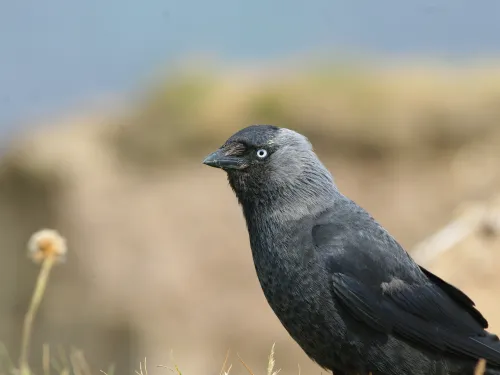
The jackdaw is a small, black-capped crow of woodlands, parks, towns and coast. It is a well-known thief, stealing other birds' eggs and breaking into garden feeders.
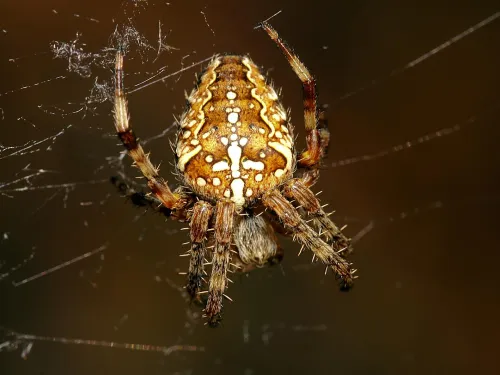
Have you ever stopped to look at the shape of a spider web? Garden spiders spin a spiral shaped web, perfect for catching lots of juicy prey!
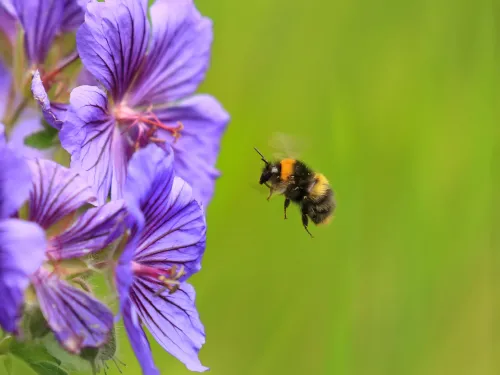
One of our prettiest and smallest bumble bees, the early bumblebee has a bright orange tail and lemon-yellow bands on its body. It is very common and can be found in all kinds of habitats in early spring.
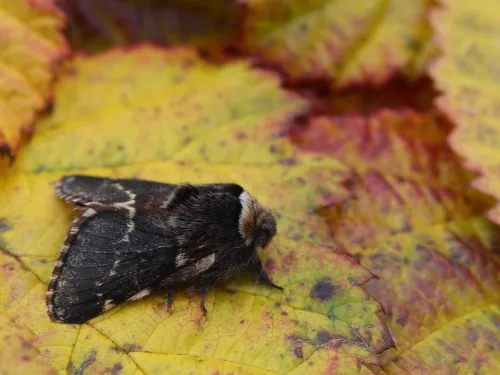
This fluffy moth is one of the few species that fly in winter.
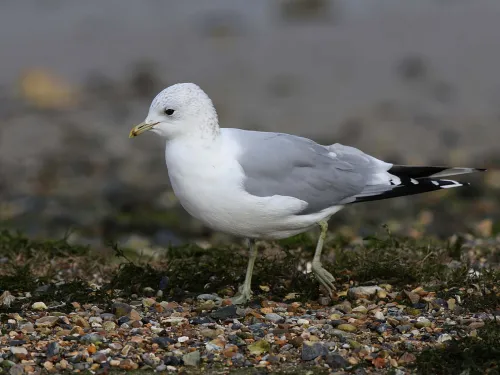
Despite its name, the common gull is not as common as some of our other gulls. It can be spotted breeding at the coast, but is also partial to sports fields, landfill sites and housing estates in winter.
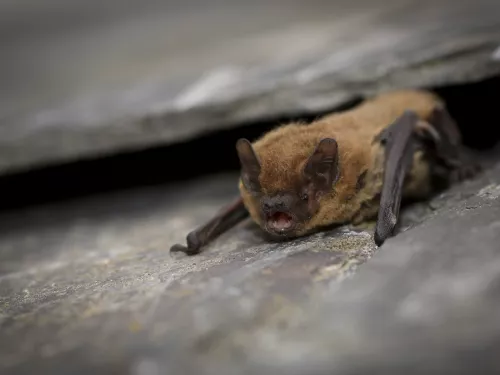
The common pipistrelle is so small, it can fit into a matchbox! Despite its size, it can easily eat 3,000 insects a night: look for it flitting around the garden or a lit lamp post as it chases its prey.
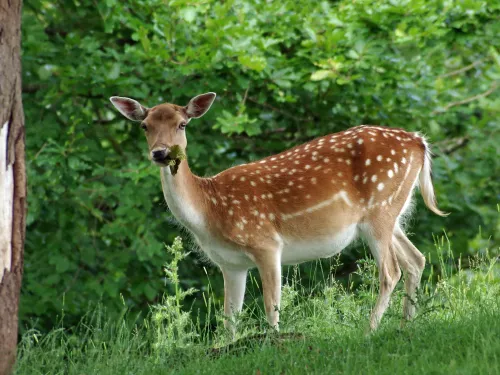
Although introduced by the Normans, the fallow deer has been here so long that it is considered naturalised. Look out for groups of white-spotted deer in woodland glades.
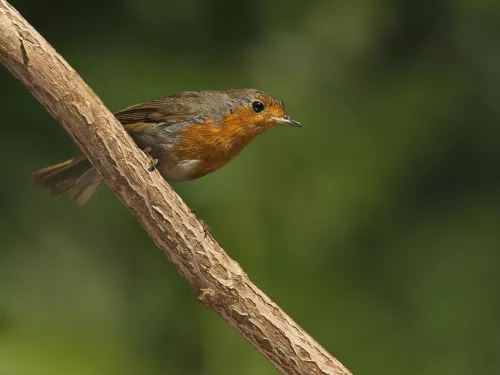
The much-loved robin is a garden favourite and one of our most familiar birds, adorning Christmas cards every year. It is very territorial, however, and will defend its post with surprising ferocity.
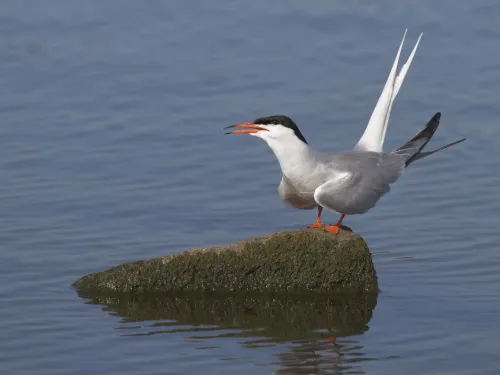
During the breeding season, the common tern can be seen around our coasts and also inland at gravel pits, reservoirs and lakes. It nests in noisy colonies and can be spotted plunge-diving for fish.

The Blue-tailed damselfly does, indeed, have a blue tail. It is one of our most common species and frequents gardens - try digging a wildlife pond to attract dragonflies and damselflies.
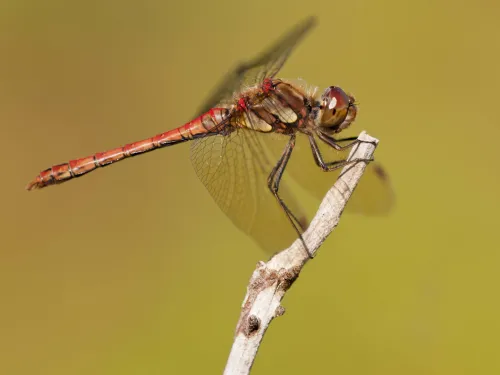
The Common darter is a red, narrow-bodied dragonfly that can be seen throughout summer and autumn. It is hovers around all kinds of waterbodies, darting out to surprise its prey.

The Purple hairstreak is an elusive butterfly with a brilliant purple sheen. It is entirely reliant on oak trees and can be spotted chasing around the treetops in woodlands and parks.
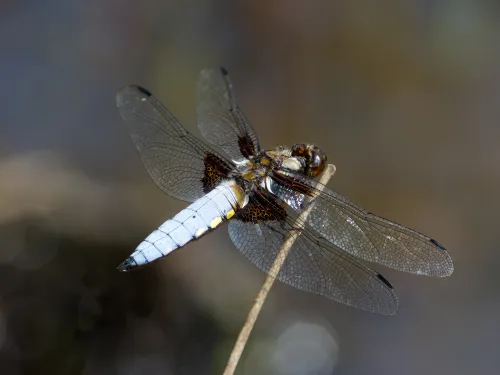
The Broad-bodied chaser is a common dragonfly that can be seen in summer around ponds and lakes, and even in gardens. It lives up to its name: its flattened body gives it a fat, broad look.
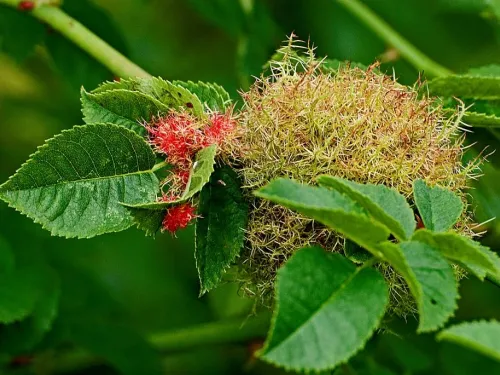
Living up to its name, the Robin's pincushion is a red, round, hairy growth that can be seen on wild roses. It is caused by the larvae of a tiny gall wasp that feeds on the host plant, but causes little damage.

The Oak bush-cricket is arboreal and can be found in mature trees in woods, hedges, parks and gardens in summer. Males don't have a 'song' as such, but drum on leaves with their hind legs to attract females.
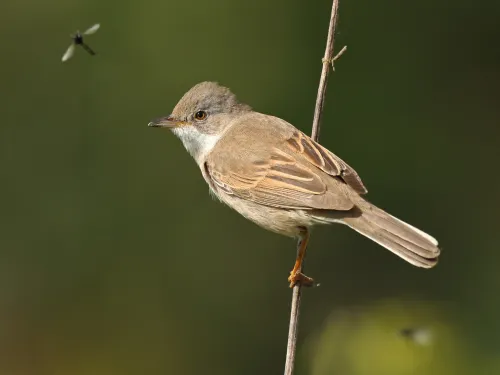
The male whitethroat does, indeed, have a white throat! Arriving from Sub-Saharan Africa in April, it can be spotted on grassland and scrub, and along hedgerows. It is bigger than the lesser whitethroat.
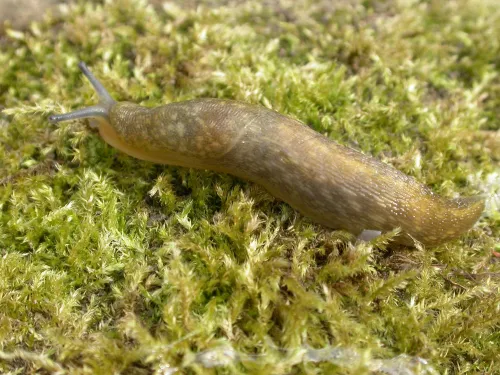
The Yellow slug lives up to its name - its yellow body is mottled with grey patches. Often found in gardens and damp places in houses, it can be considered a pest, but is an important nutrient recycler.
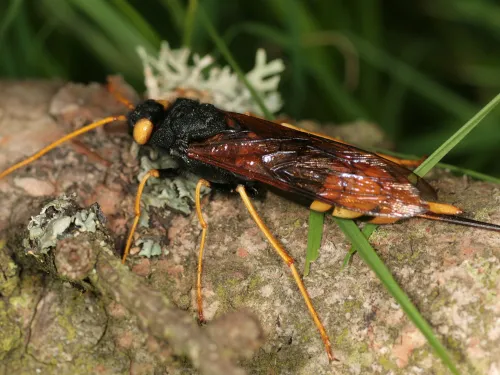
With yellow-and-black bands, the giant horntail looks like a large wasp, but is harmless to us. The female uses her long, stinger-like ovipositor to lay eggs in pine trees, where the larvae then develop.
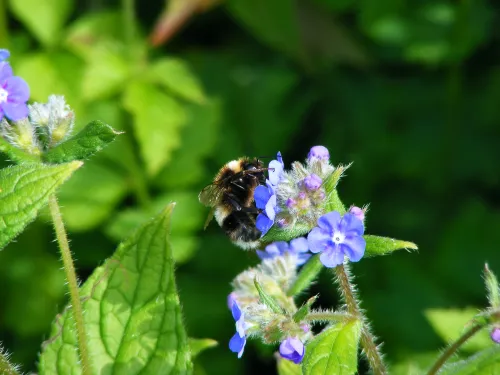
The Heath bumblebee is not only found on heathland, but also in gardens and parks. It nests in small colonies of less than 100 workers in all kinds of spots, such as old birds' nests, mossy beds and even roofs!
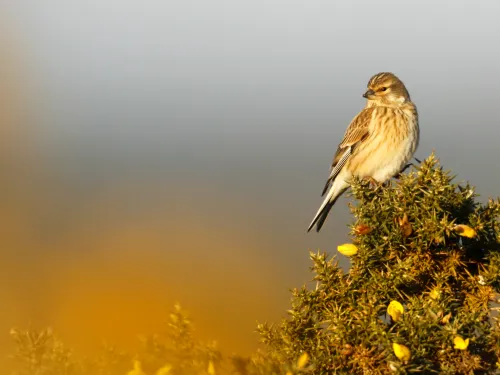
The linnet can be seen on farmland and heathland across the UK. But, like so many other farmland birds, linnets are declining rapidly, mainly due to agricultural intensification.

The song of the Roesel's bush-cricket is very characteristic: long, monotonous and mechanical. It can be heard in rough grassland, scrub and damp meadows in the south of the UK, but it is spreading north.
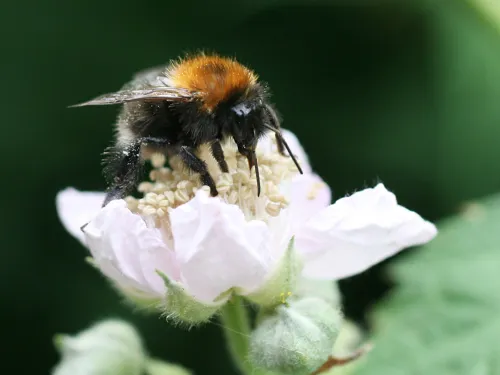
The Tree bumblebee is a new arrival to the UK. First recorded here in 2001, it is slowly spreading north. It prefers open woodland and garden habitats and can be found nesting in bird boxes and roof spaces.
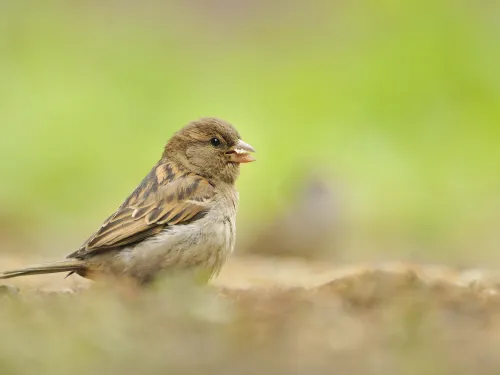
The house sparrow is a familiar, streaky brown bird of towns, parks and gardens. Males sport a grey cap and black bib, the size of which indicates their status.
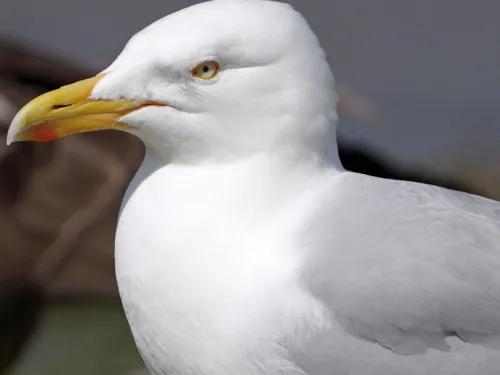
The herring gull is the typical 'seagull' of our seaside resorts, though our coastal populations have declined in recent decades.
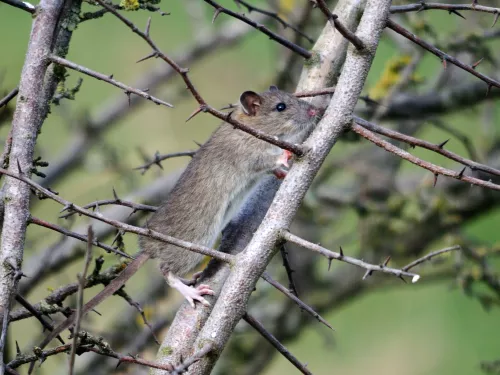
The brown rat has a bad reputation, but it mostly lives side-by-side with us without any problems. It can be seen in any habitat.
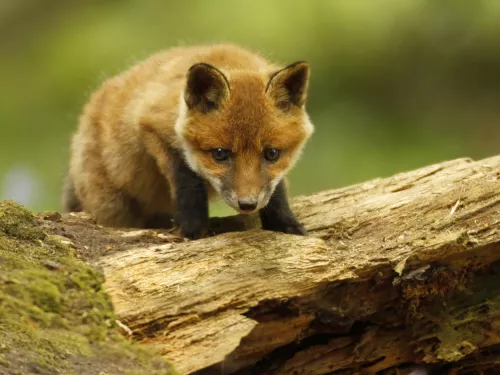
Famed for their cunning and stealth, these orangey-red dogs with their bushy tails can be seen in towns and the countryside. They come out mostly at night but can also be seen during the day if you’re lucky!
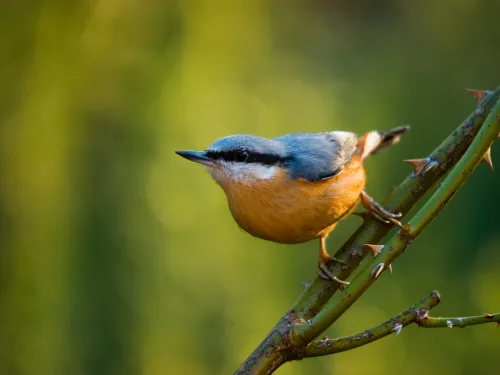
The nuthatch is a tit-sized, grey and rust-coloured bird that can be easily spotted climbing headfirst down tree trunks in woodlands and parks.
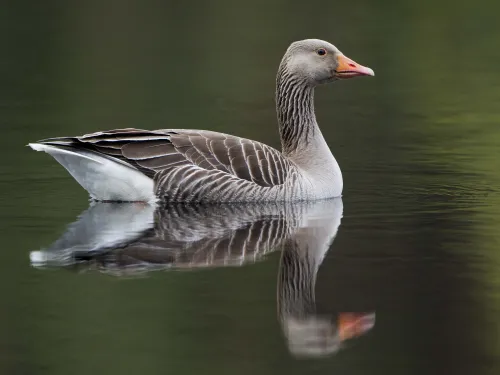
The greylag goose can be easily spotted around parks, gravel pits and river valleys, but these populations tend to be semi-tame, having been reintroduced. Truly wild populations can be found in Scotland.
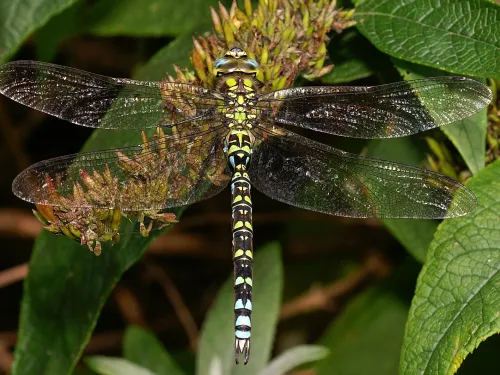
A common dragonfly of ponds, lakes and canals near woodland, the Southern Hawker can be seen patrolling the water or 'hawking' through woodland rides. A fast-flying species, it will catch its prey mid-air.

The common red soldier beetle is also known as the 'bloodsucker' for its striking red appearance, but it is harmless. It is a beneficial garden insect as the adults eat aphids, and the larvae eat other pests.
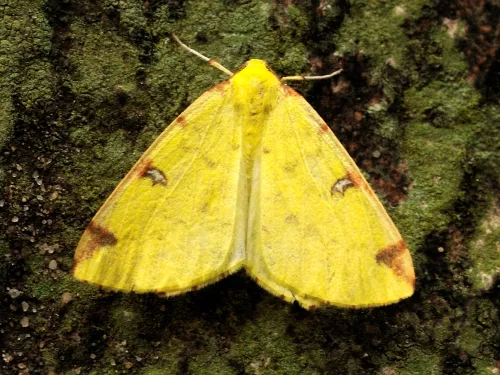
The brimstone moth is a yellow, night-flying moth with distinctive brown-and-white spots on its angular forewings. It frequently visits gardens, but also likes woods, scrub and grasslands.
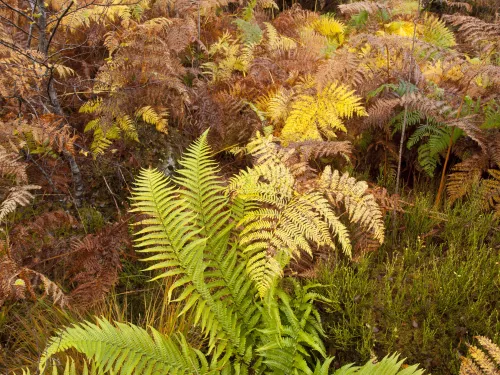
A classic fern of woodlands across the UK, the male-fern is also a great addition to any garden. It grows impressive stands from underground rhizomes, dying back in autumn.
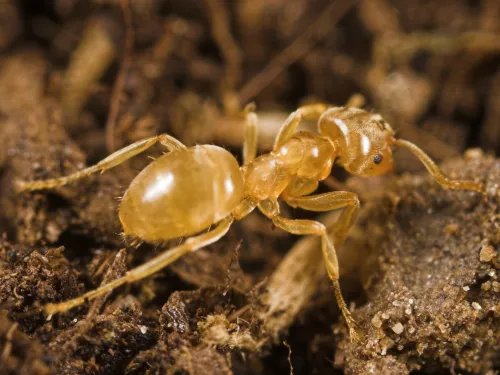
The yellow meadow ant is known for creating anthills in grassland habitats. It has a close relationship with the Chalkhill blue butterfly - protecting the larvae in return for a sugary substance they secrete.

The Dark bush-cricket, as its name suggests, is dark brown or reddish. It can be found in woodlands, hedgerows and gardens throughout summer. Its irregular chirpings are a familiar sound of summer.
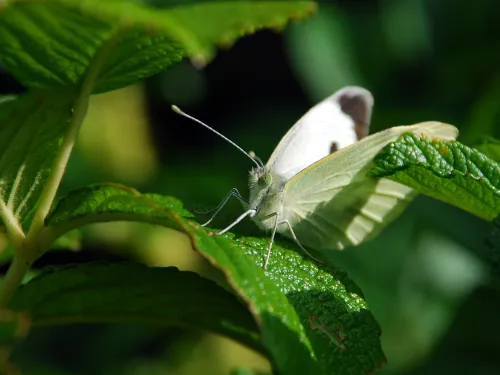
The large white is a common garden visitor - look out for its brilliant white wings, tipped with black.
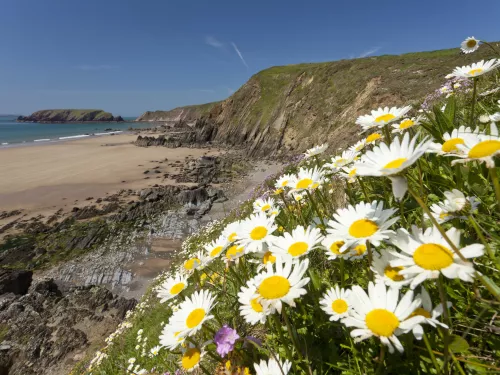
Often growing in swathes along a roadside or field margin, the oxeye daisy is just as at home in traditional hay meadows. The large, white, daisy-like flowers are easy to identify.
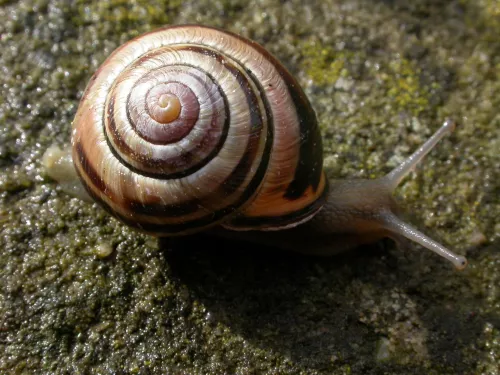
The Brown-lipped snail comes in many colour forms, but usually has a brown band around the opening of its shell. It prefers damp spots in wide range of habitats, from gardens to grasslands, woods to hedges.

The shy dunnock can be seen hopping about under hedges as its other name, 'hedge sparrow', suggests. It inhabits gardens, woodlands, hedgerows and parks.
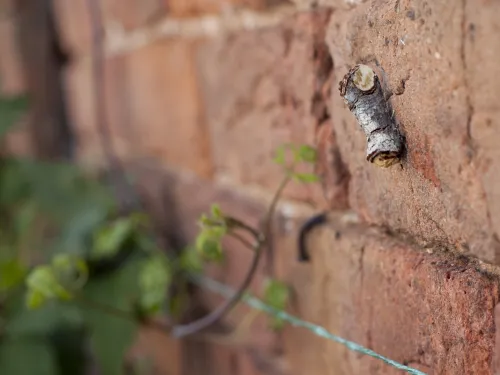
It is so easy to miss this clever little moth. It is a master of disguise, blending in perfectly as it looks just like the twig of a birch tree! Flying only at night, the buff-tip moth can be seen from May to July.
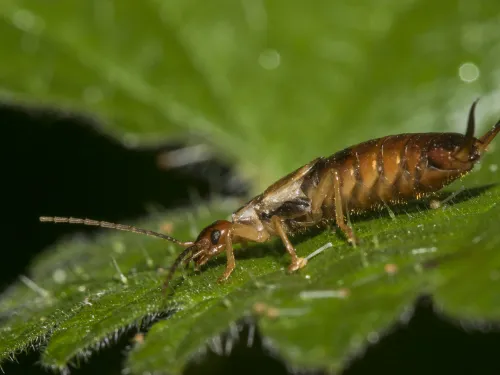
Despite popular belief, and its name (from the Old English for 'ear beetle'), the Common earwig will not crawl into your ear while you sleep - it much prefers a nice log or stone pile! It feeds on organic matter, recycling important nutrients.
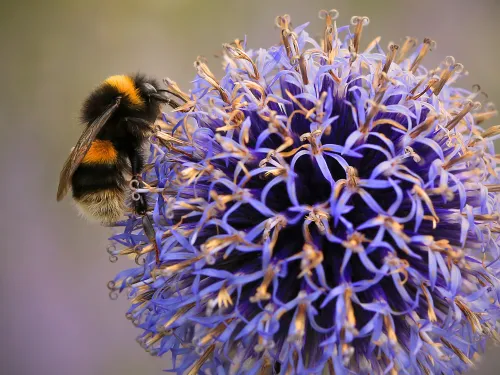
Spot these giants of the bumblebee world during springtime. They can be seen buzzing from flower to flower getting their pollen fix.
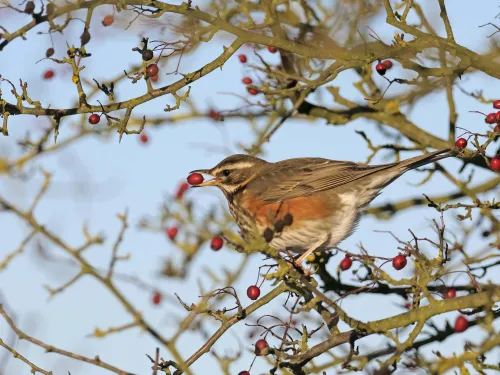
The redwing is a winter visitor, enjoying the feast of seasonal berries the UK's hedgerows, gardens and parks have to offer. Look out for the distinctive orangey-red patches under its wings.
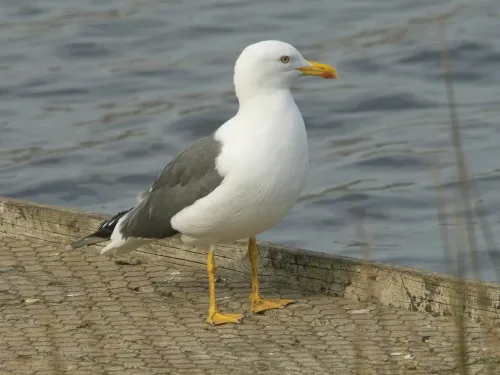
The lesser-black backed gull can be spotted around the coast in summer, with the biggest colony on Walney Island, Cumbria. Look for it over fields, landfill sites and reservoirs during winter.
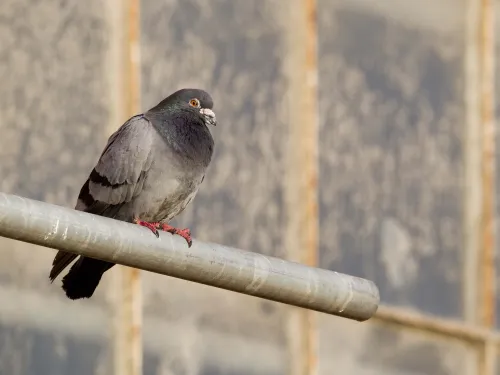
The wild rock dove is the ancestor to what is probably our most familiar bird - the feral pigeon, which is often found in large numbers in our towns and cities.
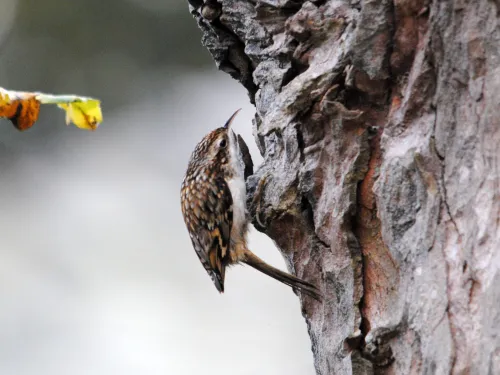
The fine, downcurved bill of the treecreeper makes this tit-sized bird unmistakeable. Look out for it in woodlands and parks, literally 'creeping' around tree trunks.
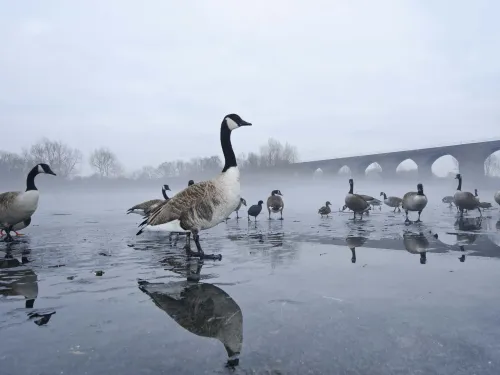
The Canada goose is our most familiar goose, although it is not actually native to the UK. A common and bold bird, it can be found around most parks, lakes, reservoirs and gravel pits.
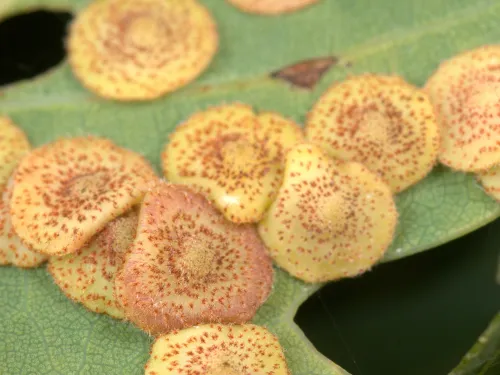
The common spangle gall wasp produces a small, disc-shaped growth, or 'gall', on the undersides of oak leaves. Inside the gall, the larvae of the wasp feed on the host tissues, but cause little damage.

When threatened, the Green tortoise beetle acts just like a tortoise, pulling its feet and antennae in and hunkering down, gripping the leaf it is on as tightly as possible. Look for it on White Dead-nettle in gardens and hedgerows.

Growing in tufts, Crested dog's-tail is a stiff-looking grass, with a tightly packed, rectangular flower spike. Look for it in lowland meadows and grasslands.
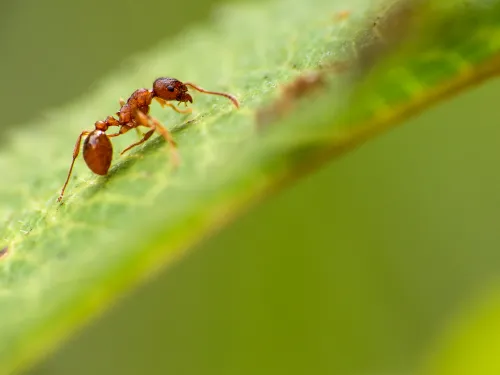
Turn over large stones or paving slabs in the garden and you are likely to find a Red ant colony. This medium-sized ant can deliver a painful sting, so be careful! In summer, winged adults swarm and mate.
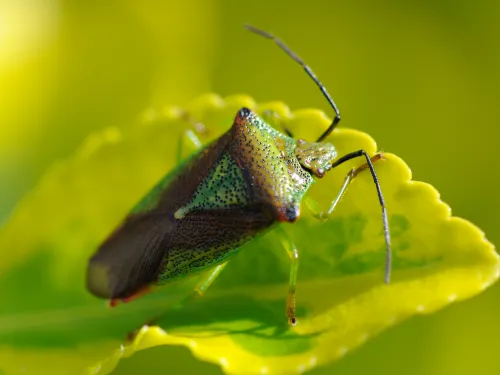
Our largest shieldbug, the red-and-green hawthorn shieldbug can be seen in gardens, parks and woodlands, feeding on hawthorn, rowan and whitebeam. The adults hibernate over winter.
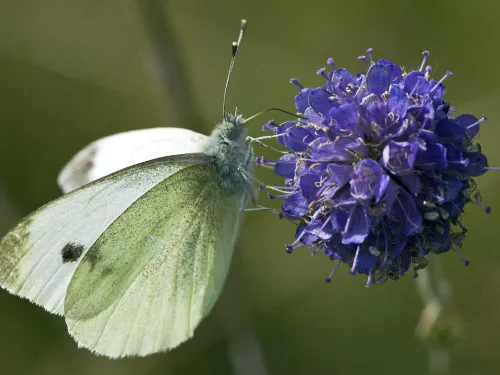
The small white is a common garden visitor. It is smaller than the similar large white, and has less black on its wingtips.

As its name suggests, the zebra spider has the familiar black-and-white stripes of a zebra, making it very distinctive. It can be found stalking its prey on rocks, trees and walls, particularly in gardens.
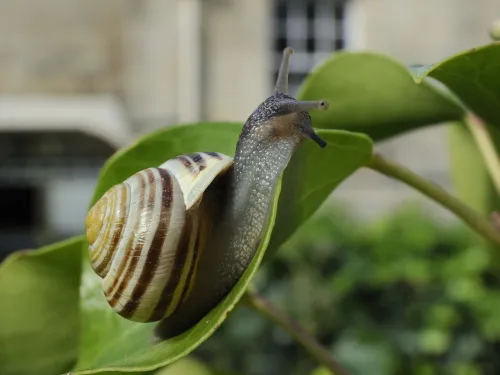
The White-lipped snail comes in different colour forms, but always has a white band around the opening of its shell. It prefers damp spots in wide range of habitats, from gardens to grasslands, woods to hedges.
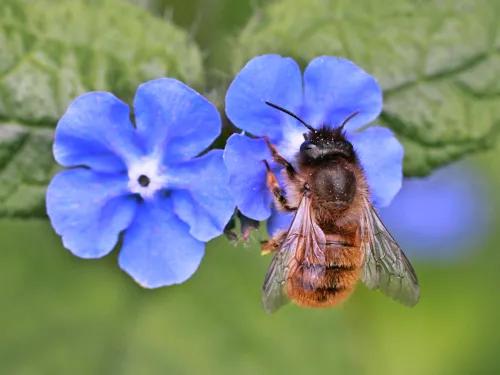
The Red Mason Bee is a common, gingery bee that can be spotted nesting in the crumbling mortar of old walls. Encourage bees to nest in your garden by putting out a tin can full of short, hollow canes.
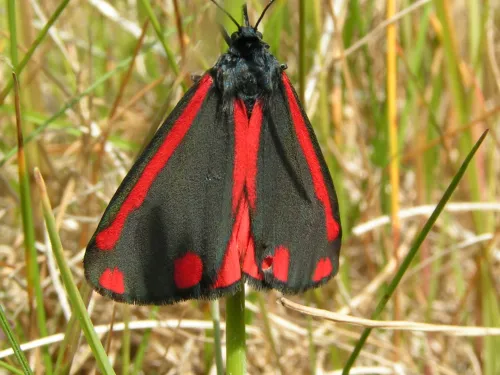
These pretty black and red moths are often confused for butterflies! Their black and yellow caterpillars are a common sight on ragwort plants. The caterpillar’s bright colours warn predators not to eat them, giving a strong signal that they are poisonous!
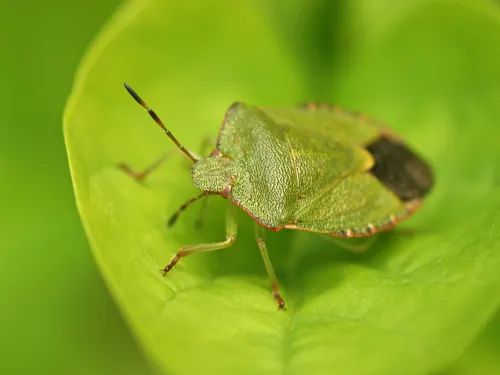
The common shieldbug was once restricted to Southern England, but has since been moving northwards and is now quite widespread. It can be found in all kinds of habitats from gardens to farms.
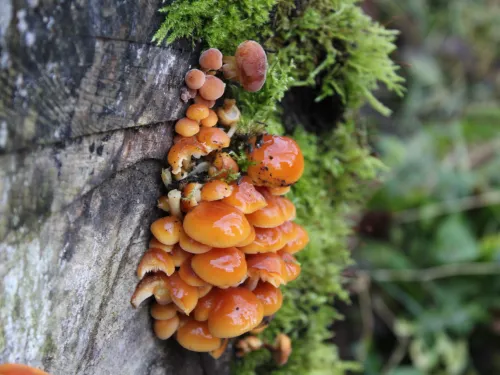
The velvet shank can be found clustered on the dead and dying wood of deciduous trees, such as elm, ash, beech or oak. It has a bright orange cap and can be seen throughout winter.
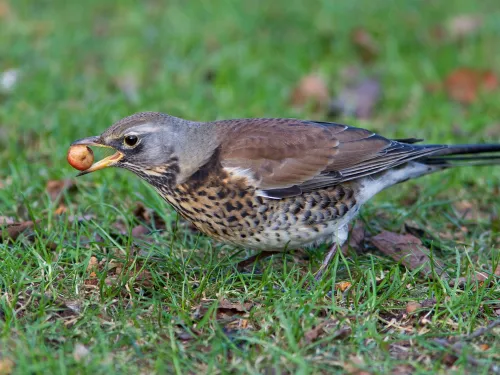
Often spotted in large flocks, the fieldfare is an attractive thrush. It is a winter visitor, enjoying the feast of seasonal berries the UK's hedgerows, woodlands and parks have to offer.

The red admiral is an unmistakable garden visitor. This black-and-red beauty may be seen feeding on flowers on warm days all year-round. Adults are mostly migrants, but some do hibernate here.

The large, plump woodpigeon is a familiar sight in our gardens and parks, but can also be found on farmland and in woodlands almost everywhere. You may hear its cooing call before you see the bird itself.
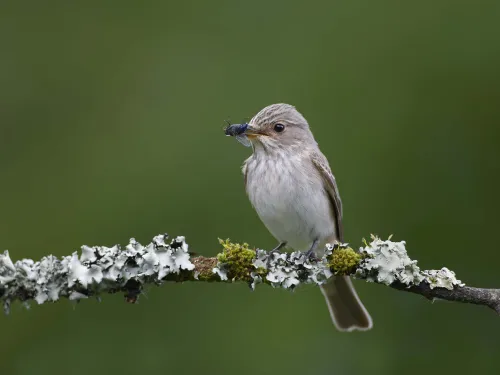
Watch the deadly accurate flying of the spotted flycatcher in woodlands, gardens and parks. It sits quietly on a perch waiting for an unsuspecting insect to fly by, deftly dashing out to seize it.
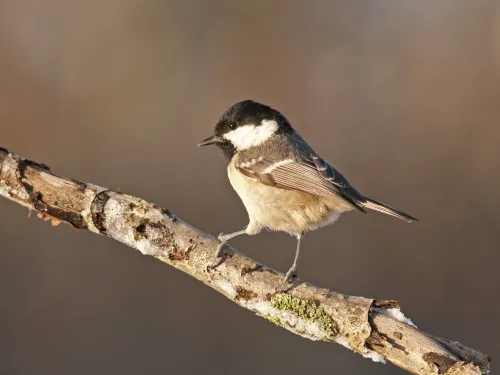
The coal tit is mainly found in coniferous woodland, but can also be spotted in gardens and parks. It is smaller than the great tit, but has a similar bicycle pump-like song.
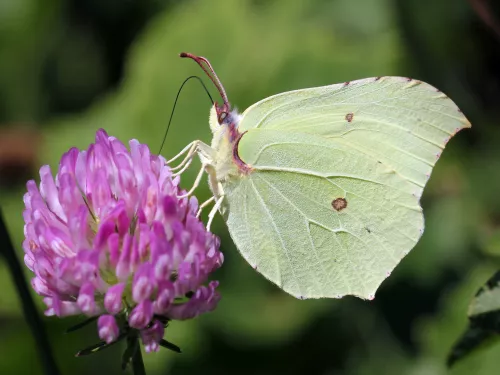
One of the joys of a spring day is watching a fluttering, lemon-yellow brimstone alight on a flower - an early sign that the seasons are changing. It is commonly spotted in gardens, woodland and parks.

The oak marble gall wasp produces brown, marble-shaped growths, or 'galls', on oak twigs. Inside the gall, the larvae of the wasp feed on the host tissues, but cause little damage.
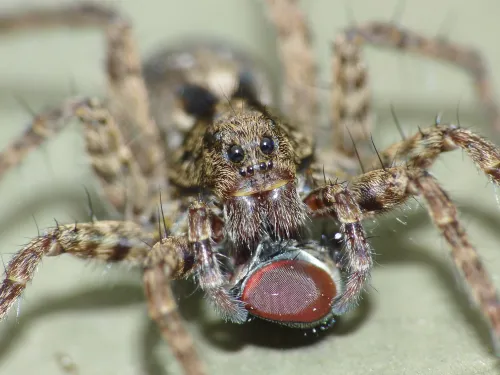
The wolf spider can be found in a wide range of habitats, including the garden. It hunts down its prey, leaping on it just like a wolf. Spiders are beneficial neighbours, helping to manage garden pests.
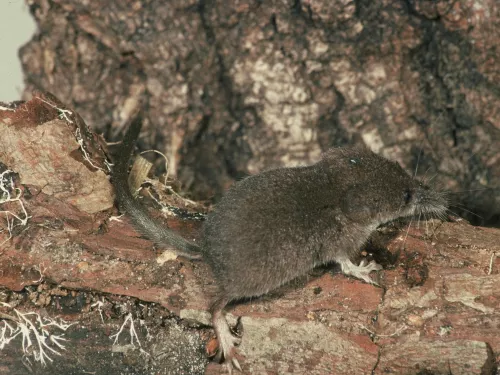
The diminutive pygmy shrew has a distinctively pointy nose and tiny eyes. It lives life in the fast lane, eating every 2-3 hours to survive, and only living for a year or so. Look out for it in the garden.

A tussocky sedge, Greater pond sedge has stout, upright flower spikes, strap-like leaves and triangular stems. It prefers lowland wetland habitats on heavy soils.
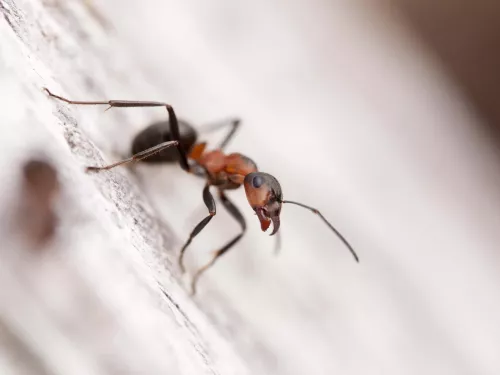
The most common wood ant is the southern wood Ant, or 'red wood ant', which is found in England and Wales. An aggressive predator, it plays a vital pest control role in our woodlands.
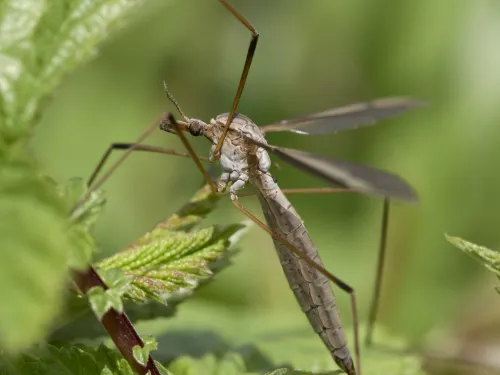
Flitting about the house in summer, the gangly, brown daddy longlegs is familiar to many of us. They are a valuable food source for many birds.
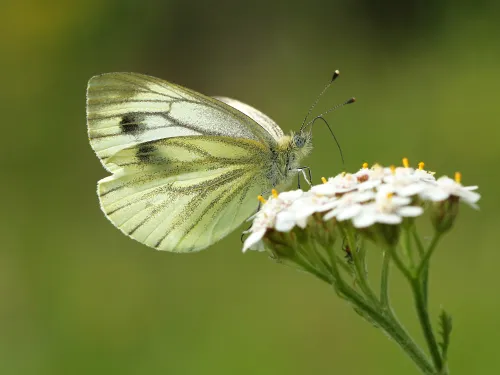
The green-veined white is a common butterfly of hedgerows, woodlands, gardens and parks. It is similar to other white butterflies, but has prominent green stripes on the undersides of its wings.
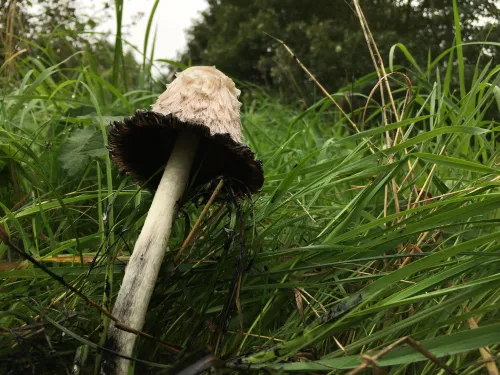
As its name suggests, the shaggy inkcap, or 'lawyer's wig', has a woolly, scaly surface to its bell-shaped toadstools. It is very common and can be seen at the road side, in parklands and even popping up in lawns.

The mohawk-sporting caterpillar of this moth is often seen on shrubs and trees in late summer. As adults the orange-brown males fly by day, but the flightless females don't stray far from their cocoon.
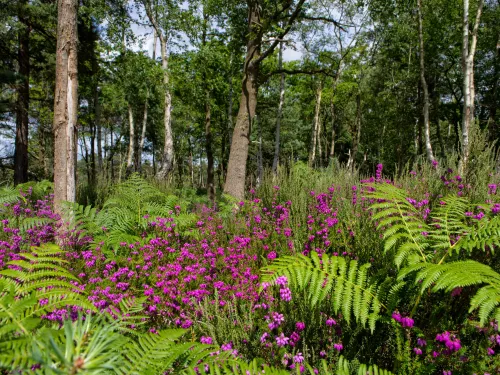
Our most familiar fern, bracken can be found growing in dense stands on hillsides, moorland, heathland and in woodlands. It is very large and dies back in winter, turning the landscape orangey-brown.
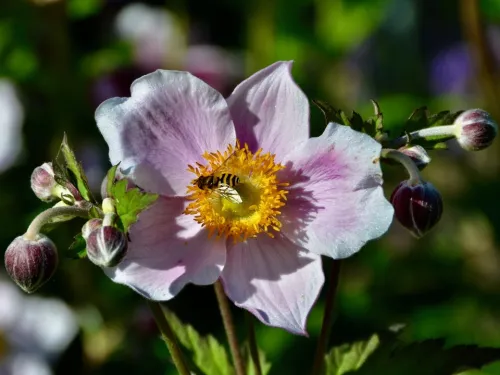
The Common banded hoverfly has a fitting name: it is not only one of our most common species, its black body is also covered in yellow bands! It can be seen in many habitats from gardens to woodlands.

The lilac-blue wood blewit grows in woodland and parkland. It is edible and gathering wild food can be fun, but it's best to do it with an expert - pop along to a Wildlife Trust event to try it.
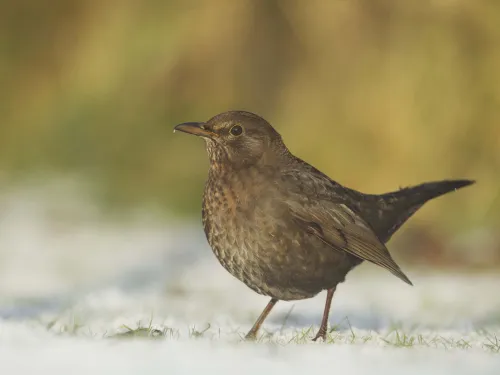
A much-loved garden bird, the blackbird is famous for its harmonious song. In winter, our resident birds are joined by migrants from Scandinavia and the Baltics.
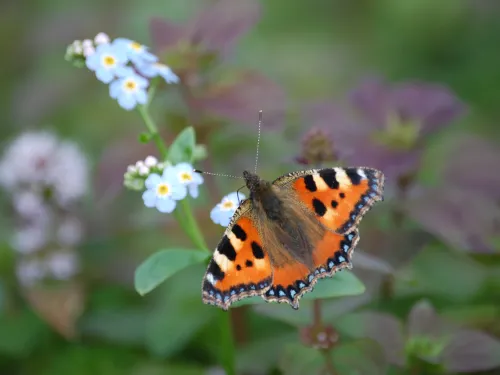
The pretty small tortoiseshell is a familiar garden visitor that can be seen feeding on flowers all year-round during warm spells. Overwintering adults may find resting spots in sheds, garages or even houses.
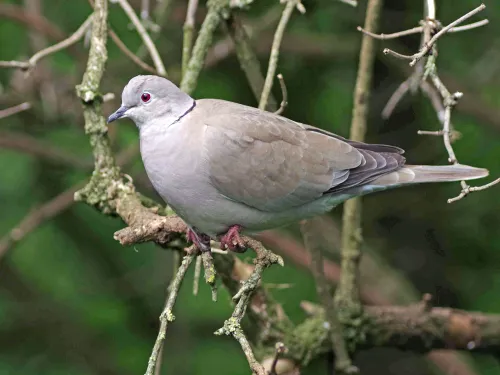
The collared dove is a pretty little pigeon that is a regular sight in our gardens, woodlands and parks. Listen out for its familiar cooing call, which you may hear before you see the bird itself.

This unique fungus is one of the most sought after spring fungi of them all.
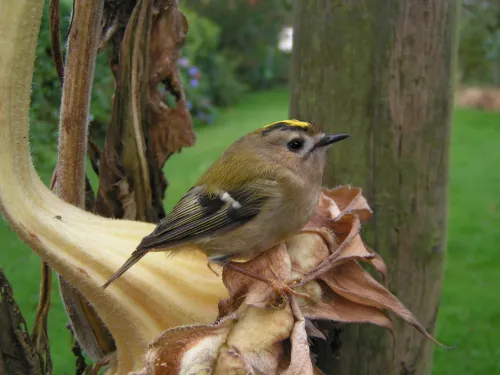
A king among birds, the goldcrest displays a beautiful golden crown. Our smallest bird, it can be spotted in conifer woodlands and parks across the UK.
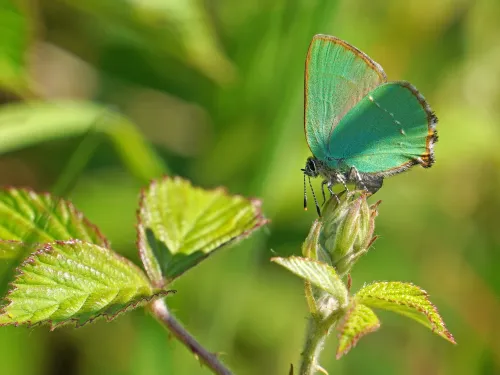
The green hairstreak is the UK's only green butterfly. Look out for the vibrant, metallic sheen of the undersides of its wings on grassland and moorland, and along woodland rides.
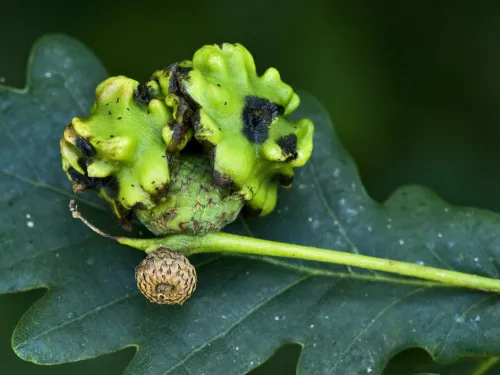
The knopper gall wasp produces knobbly red, turning to brown, growths, or 'galls', on the acorns of Pedunculate Oak. Inside the gall, the larvae of the wasp feed on the host tissues, but cause little damage.
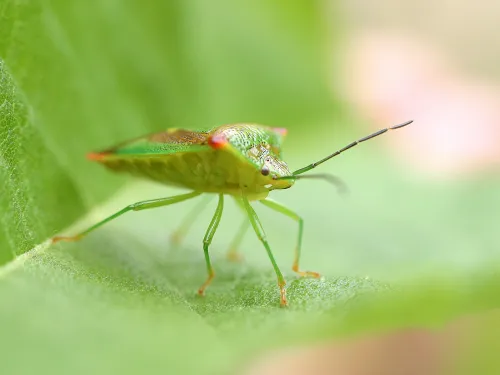
As its name suggests, the birch shieldbug can be found feeding on silver birch, and sometimes hazel, in mixed woodland. Adults hibernate over winter, emerging in spring to lay their eggs.
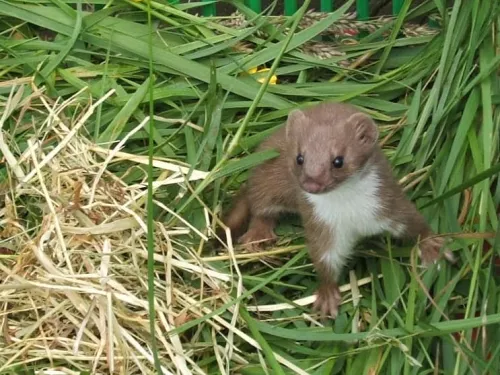
Weasels may look adorable, but they make light work of eating voles, mice and birds! They are related to otters and stoats, which is obvious thanks to their long slender bodies and short legs.
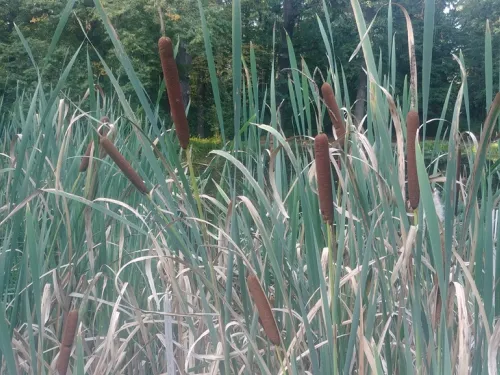
Great reedmace is familiar to many of us as the archetypal 'bulrush'. Look for its tall stems, sausage-like, brown flower heads and green, flat leaves at the water's edge in our wetland habitats.
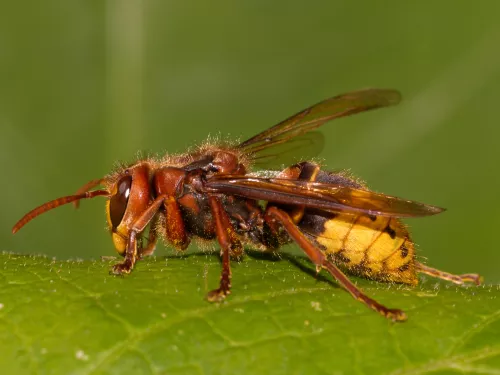
The fearsome-looking hornet may not be a well-loved insect, but it is actually much less aggressive than the common wasp. It is also an important pollinator and a predator of species that feed on plants and crops, so can be a gardener's friend.
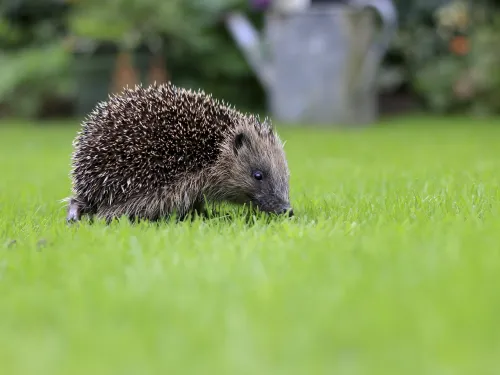
Considered a gardener’s best friend, hedgehogs will happily hoover up insects roaming in vegetable beds. Famously covered in spines, hedgehogs like to eat all sorts of bugs and crunchy beetles. They are most active at night and hibernate through winter.

The common blue butterfly lives up to its name - it's bright blue and found in all kinds of sunny, grassy habitats throughout the UK! Look out for it in your garden, too.
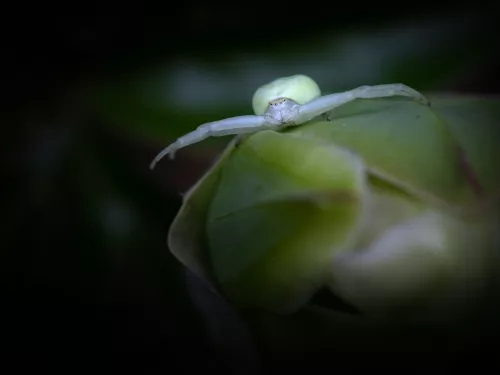
The flower crab spider is one of 27 species of crab spider. The flower crab spider can alter the colour of its body to match its surroundings and to hide from prey. It is not as common as other types of crab spider.
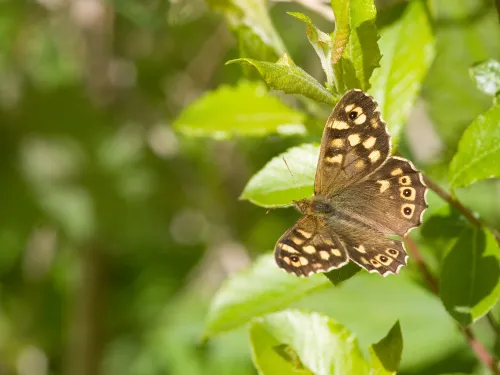
The speckled wood prefers the dappled sunlight of woodland rides and edges, hedgerows and even gardens. Despite declines, its range has spread over recent years.
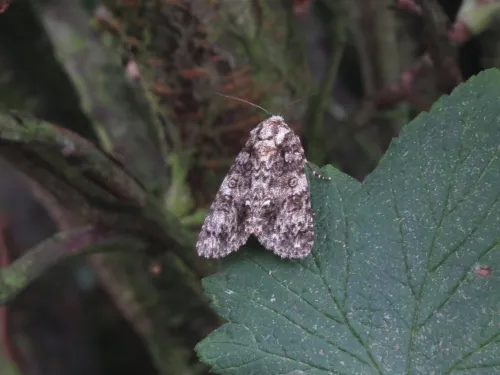
A common moth across most of the UK. The large, hairy caterpillars are often seen in late summer.
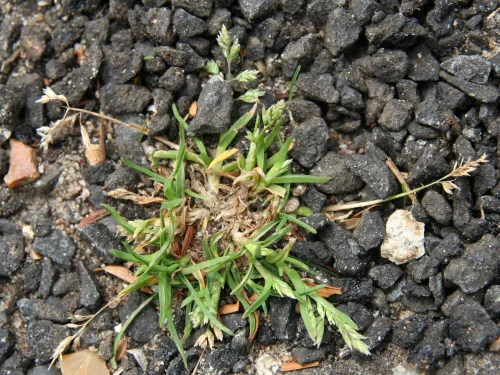
Annual meadow-grass is a coarse, vigorous grass that can be found on waste ground, bare grassland and in lawns. In some situations, it can be considered a weed.
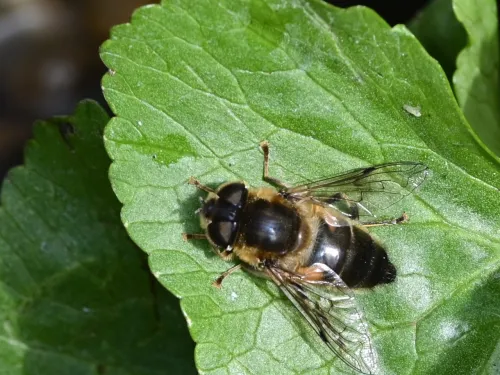
With brown-and-orange markings, the Drone-fly looks like a male Honeybee, but is harmless to us. This mimicry helps to protect it from predators while it searches for nectar in gardens and urban areas.
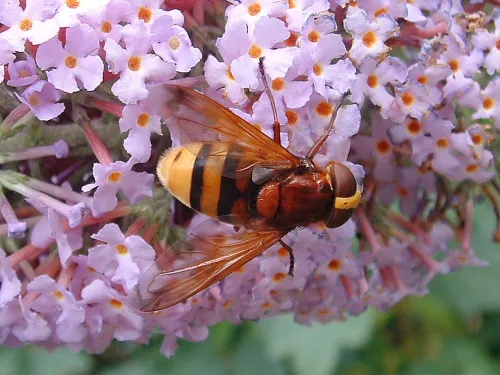
With black-and-yellow markings, the hornet mimic hoverfly looks like its namesake, but is harmless to us. This mimicry helps to protect it from predators while it searches for nectar.
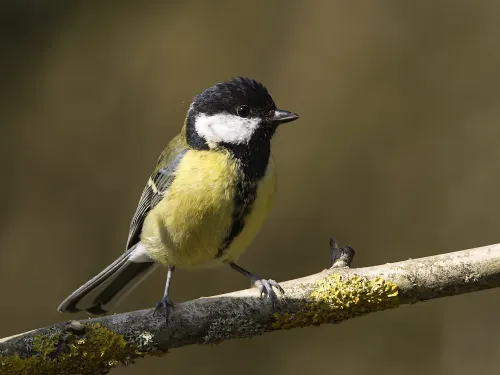
A familiar garden bird, the great tit can be seen around bird tables and feeders, as well as in woodlands and parks. Listen out for its shrill song that sounds just like a bicycle pump being used!
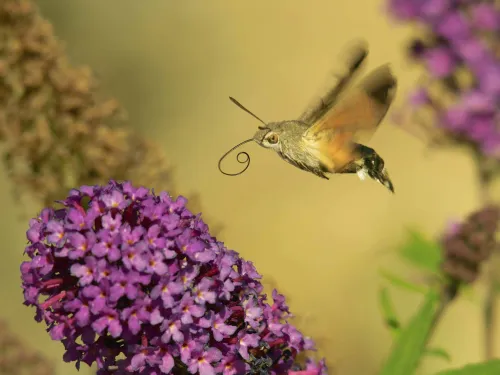
The humming-bird hawk-moth migrates to the UK from Southern Europe each year. It can be seen hovering over flowers, feeding with its long proboscis; its wings move so quickly that it 'hums'.
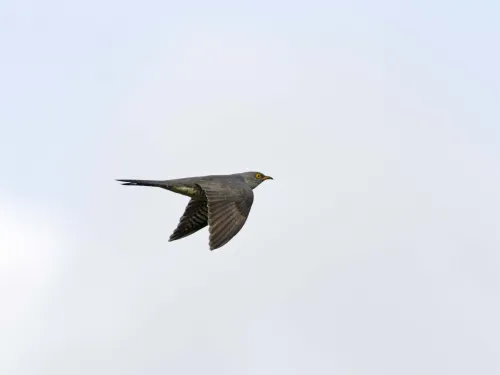
Considered to be an early sign of spring, the song of the cuckoo sounds the same as its name: ‘cuck-oo’. It can be heard in woodlands and grasslands. Cuckoos famously lay their eggs in the nests of other birds.
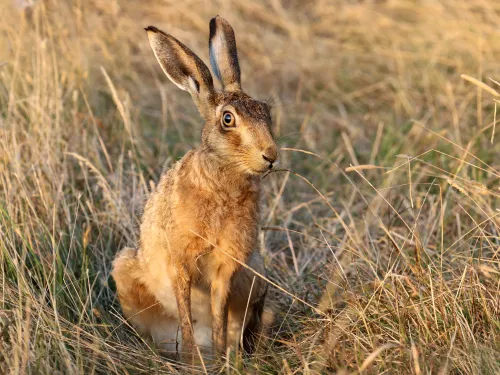
The brown hare is known for its long, black-tipped ears and fast running - it can reach speeds of 45mph when evading predators.
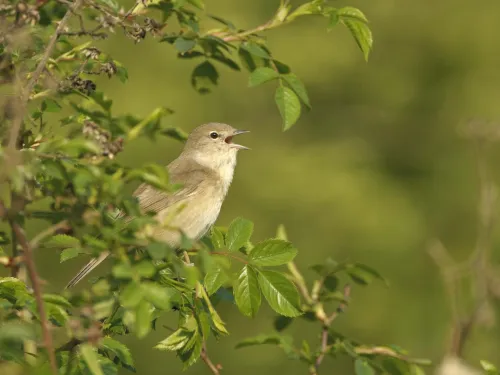
A plain-looking warbler, the garden warbler is a summer visitor to the UK. It is a shy bird and is most likely to be heard, rather than seen, in woodland and scrub habitats.
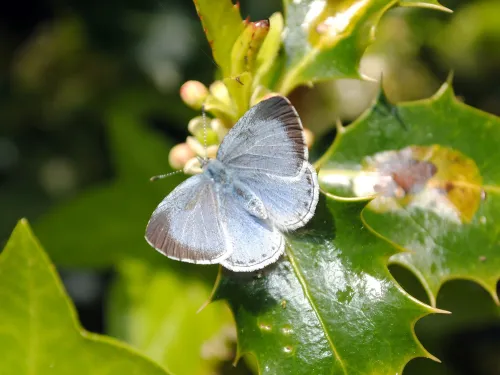
Look out for the small Holly Blue in your garden or local park. It is the first blue butterfly to emerge in spring, and a second generation appears in summer. The caterpillars are fond of holly and ivy.
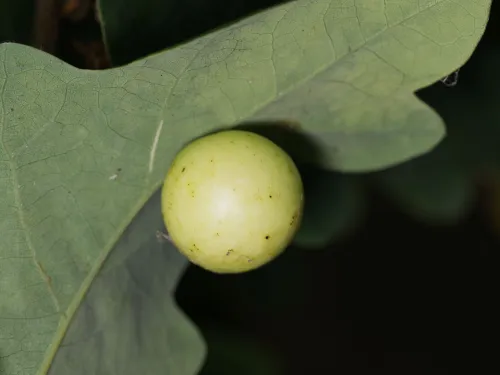
Living up to its name, the cherry gall wasp produces growths, or 'galls', on oak leaves that look like red cherries. Inside the gall the larvae of the wasp feed on the host tissues but cause little damage.

The Parent bug lives up to its name. The female lays her eggs on a Silver birch leaf, watching over them until they hatch. She stays with the young until they are adults. Other shield bugs lay their eggs and leave.
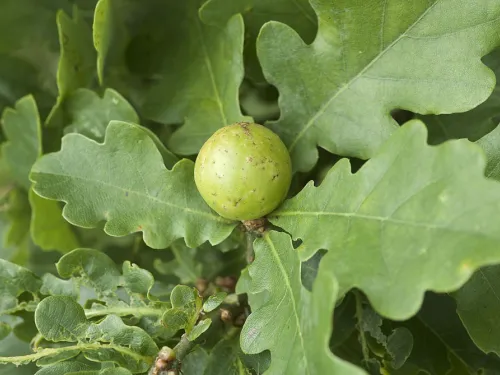
Living up to its name, the oak apple gall wasp produces growths, or 'galls', on oak twigs that look like little apples. Inside the gall, the larvae of the wasp feed on the host tissues, but cause little damage.
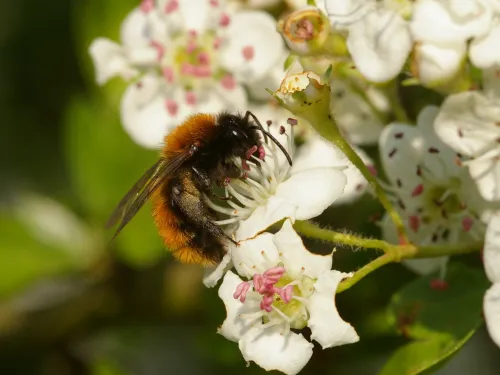
The Tawny mining bee is a furry, gingery bee that can often be seen in parks and gardens during the springtime. Look for a volcano-like mound of earth in the lawn that marks the entrance to its burrow.
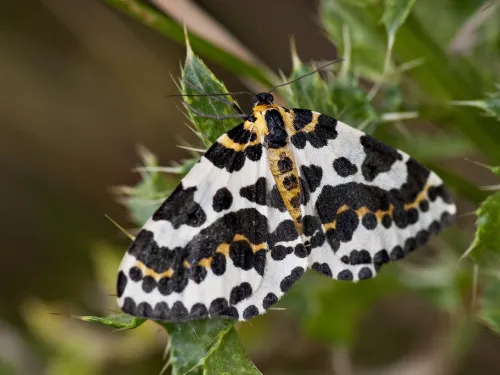
The magpie is a distinctive moth with striking black and yellow spots on white wings. It is a frequent garden visitor, but also likes woodland, scrub and heathland.
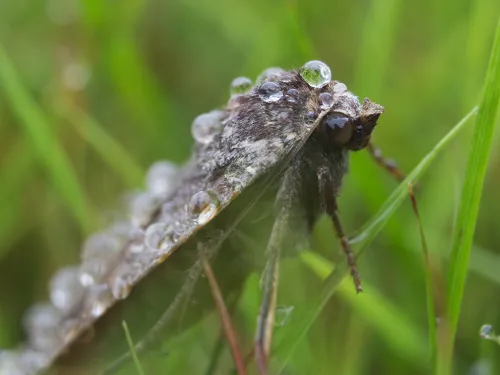
Found almost everywhere, the large yellow underwing is a night-flying moth that is often attracted to lights. It is brown with orangey-yellow hindwings.
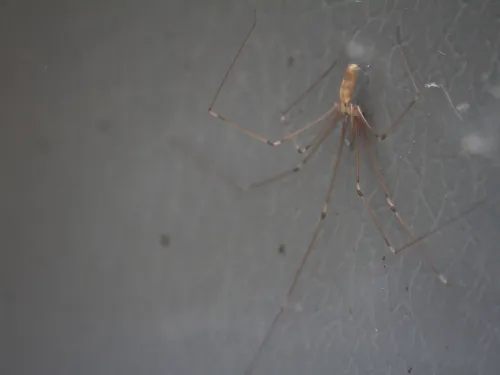
You've probably spotted this long-legged spider hiding in the corner of a house or building.
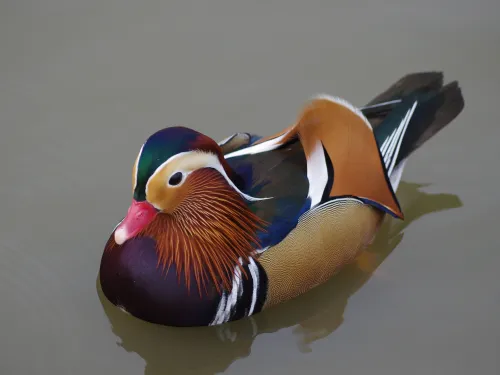
A pretty and distinctive little waterbird, the mandarin duck was introduced from the Far East as its name suggests. Oddly for a duck, it nests in trees, sometimes high above the water.
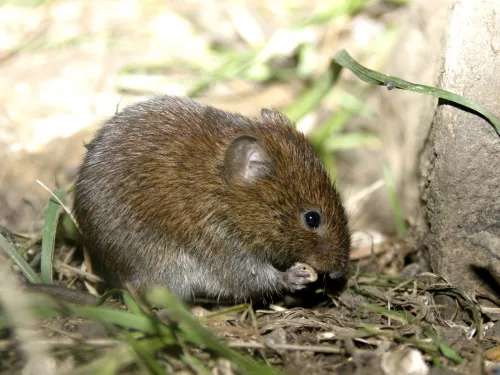
The chestnut-brown bank vole is our smallest vole and can be found in hedgerows, woodlands, parks and gardens. It is ideal prey for owls, weasels and kestrels.
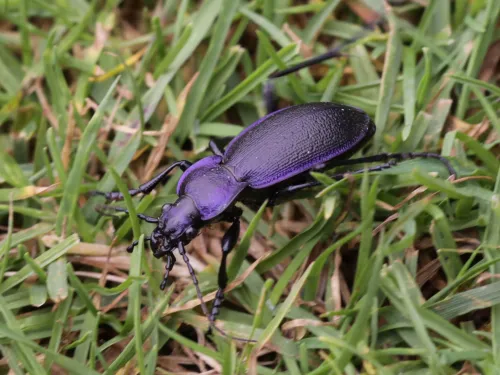
Violet ground beetles are active predators, coming out at night to hunt slugs and other invertebrates in gardens, woodlands and meadows.
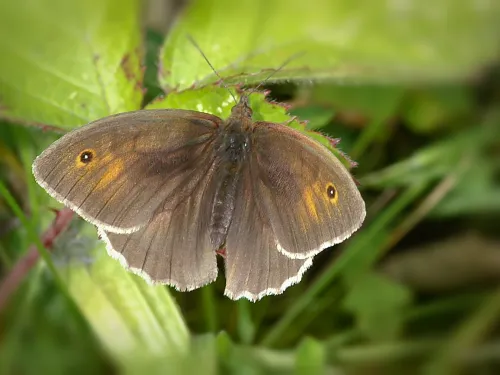
One of our most common butterflies, the meadow brown can be spotted on grasslands, and in gardens and parks, often in large numbers. There are four subspecies of meadow brown.
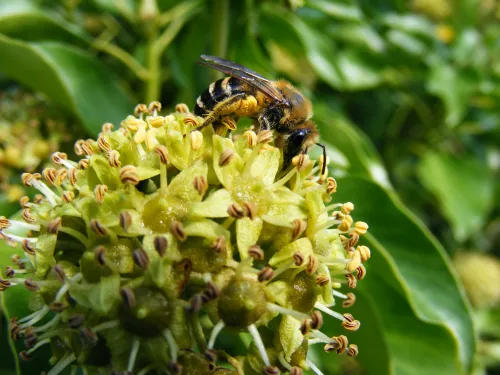
The Ivy Bee is a new arrival to the UK. First recorded here in 2001, it is slowly spreading north. It feeds exclusively on the nectar of Ivy flowers and can be seen in autumn when this plant is in bloom.

A familiar garden bird, the blue tit can be seen around bird tables and feeders, as well as in woodlands and parks. Listen out for its trilling, 'tsee-tsee-tsee' song. It is smaller than the great tit.
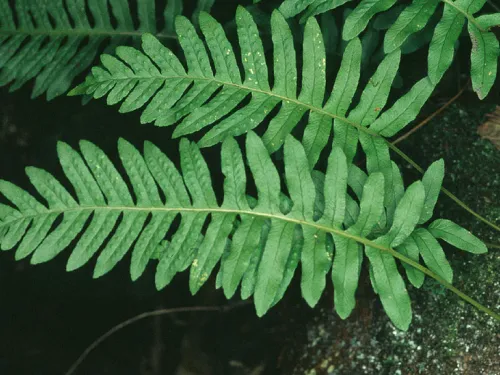
The common polypody is a hardy fern of damp, shady places in woodlands. It also makes a good garden fern. It has ladder-like, leathery foliage with pimply undersides - these spots are the spores.

The all-black carrion crow does not nest in colonies like the similar rook. It can be seen almost everywhere.
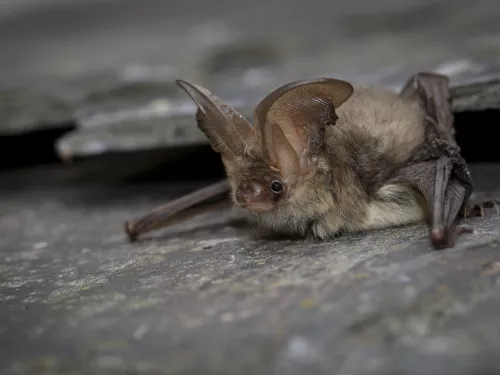
The brown long-eared bat certainly lives up to its name: its ears are nearly as long as its body! Look out for it feeding along hedgerows, and in gardens and woodland.
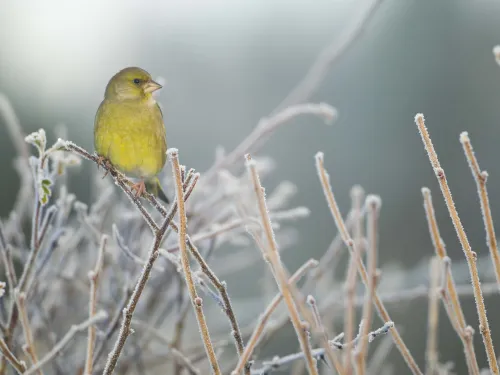
An attractive, olive-green bird, the greenfinch regularly visits birdtables and feeders in gardens. Look for a bright flash of yellow on its wings as it flies.
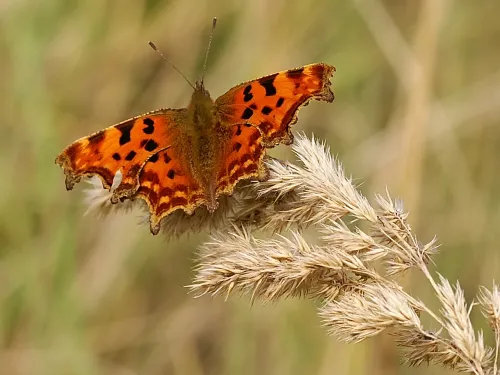
The comma has distinctively ragged wing edges, which help to camouflage it - at rest, it looks just like a dead leaf! It prefers woodland edges, but can be spotted feeding on fallen fruit in gardens.
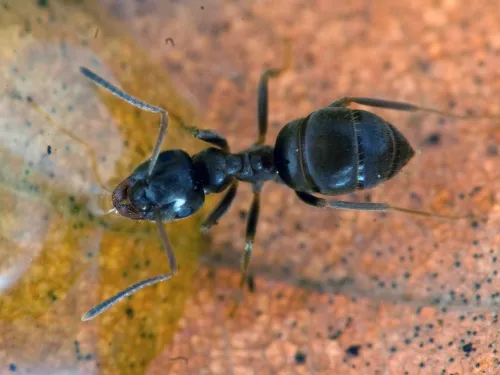
The black garden ant is the familiar and abundant small ant that lives in gardens, but also turns up indoors searching for sugary food. In summer, winged adults, or 'flying ants', swarm and mate.
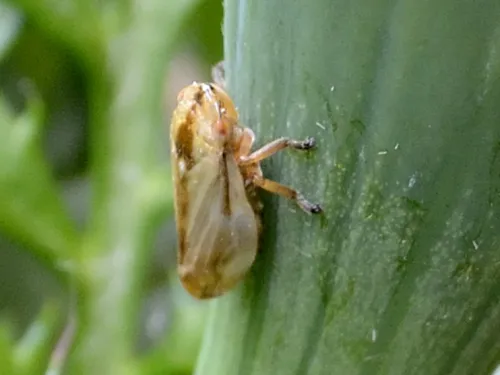
In spring and summer, look out for 'cuckoo-spit' - the frothy mass of bubbles that appears on plant stems everywhere. This is actually the protective covering for the nymphs of the tiny Common froghopper.

Despite appearances, the slow worm is actually a legless lizard, not a worm or a snake! Look out for it basking in the sun on heathlands and grasslands, or even in the garden, where it favours compost heaps.
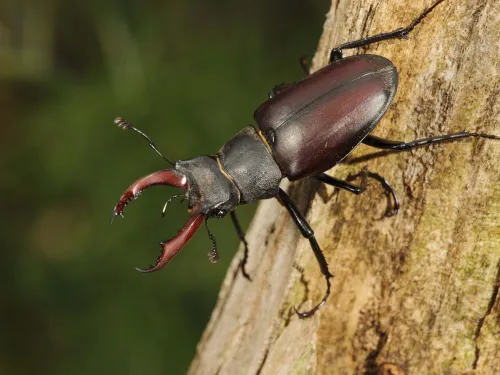
Famous for its fearsome jaws, the stag beetle does not have the bite to match. Look for it in woods, parks and gardens in South East England in summer. Males display their massive jaws to attract females and duel with their rivals.
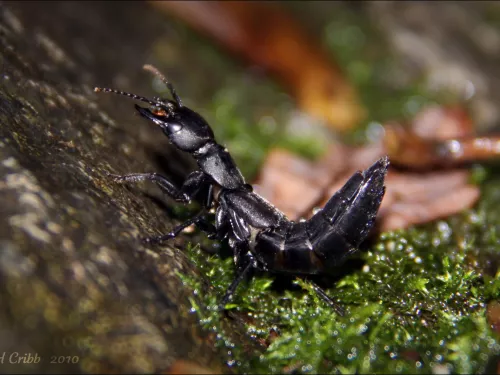
A ferocious and fast predator, the Devil's coach horse beetle hunts invertebrates after dark in gardens and on grasslands. It is well-known for curling up its abdomen like the tail of a scorpion when defending itself.
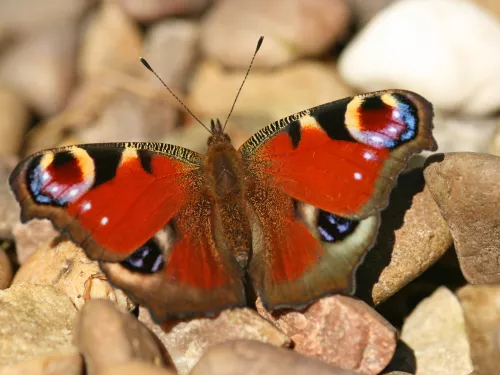
The markings of the peacock are unmistakeable - big, blue 'eyes' just like a peacock's tail feathers. It can be seen feeding on flowers all year-round during warm spells, and overwinters as an adult.
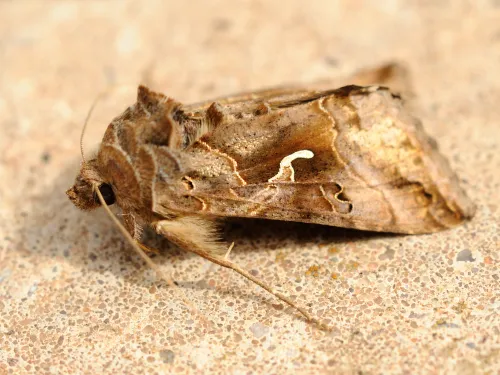
The Silver Y migrates to the UK in massive numbers each year - sometimes, an estimated 220 million can reach our shores in spring! Seen throughout the year, it is very common in gardens and grasslands.
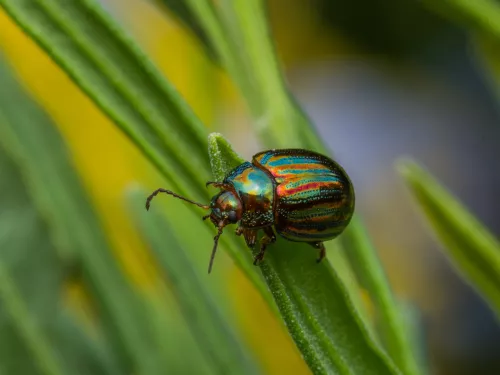
This beautiful beetle only arrived in the UK in 1960s but is now a common sight on garden herbs.
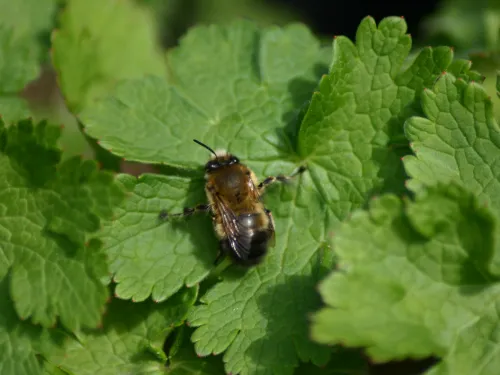
The hairy-footed flower bee can be seen in gardens and parks in spring and summer, visiting tubular flowers like red dead-nettle and comfrey. As its name suggests, it has long, orange hairs on its middle legs.
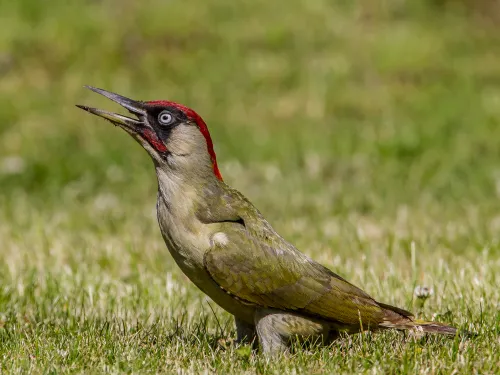
The laughing 'yaffle' call of the green woodpecker can be heard in our woodlands, parks and gardens. Look out for it hopping about your lawn, searching for ants to eat.
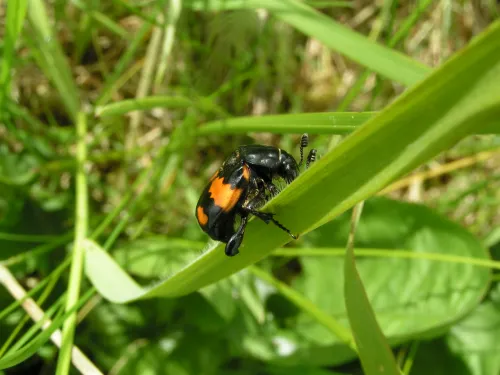
The Common sexton beetle is one of several burying beetle species in the UK. An undertaker of the animal world, it buries dead animals like mice and birds, and feeds and breeds on the corpses.
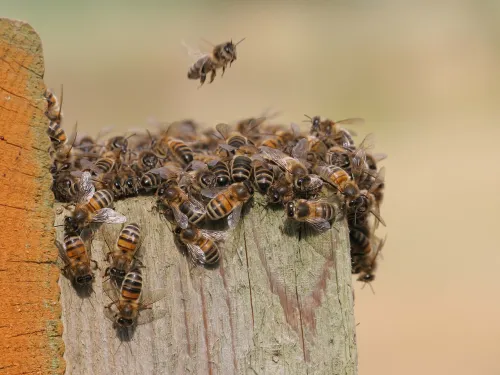
Honeybees are famous for the honey they produce! These easily recognisable little bees are hard workers, living in large hives made of wax honeycombs.
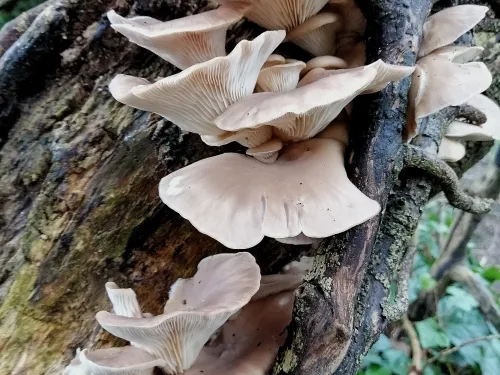
Oyster mushrooms are shell shaped fungi that grow in tiers or fabulous clusters on dead trees or stumps. Unlike many fungi, these mushrooms are not seasonal and can be found all year round, especially after a cold snap which can trigger the fungus into fruiting.
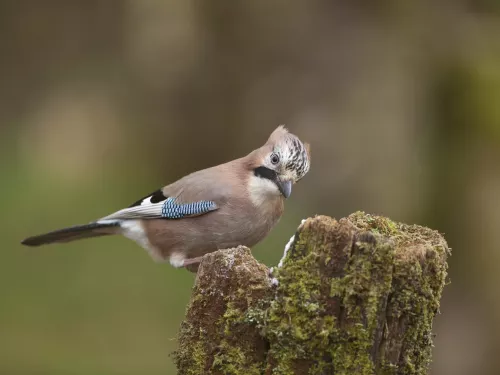
The jay is a colourful member of the crow family, with brilliant blue wing patches. It is famous for searching out acorns in autumnal woodlands and parks, often storing them for the winter ahead.
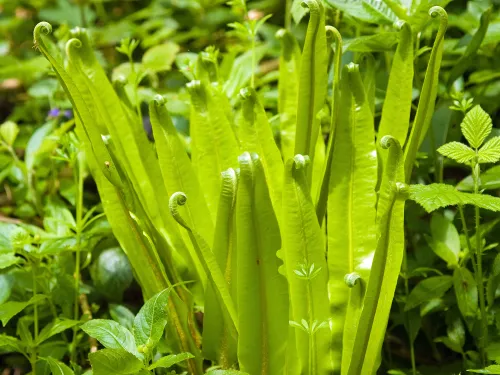
The hart's-tongue fern is a hardy fern of damp, shady places in woodlands. It also makes a good garden fern. It has simple, tongue-shaped, glossy, green leaves that have orange spores on their undersides.
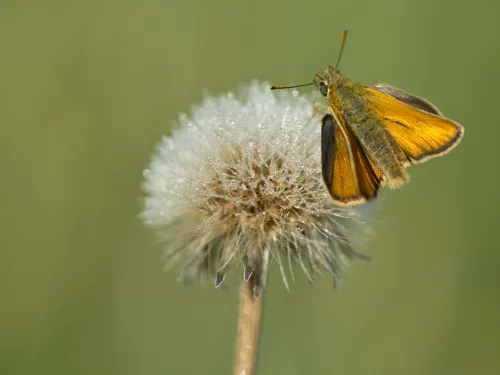
Often found basking on tall grasses, or buzzing between stems, the small skipper is a small, orange butterfly. It prefers rough grassland, verges and woodland edges.
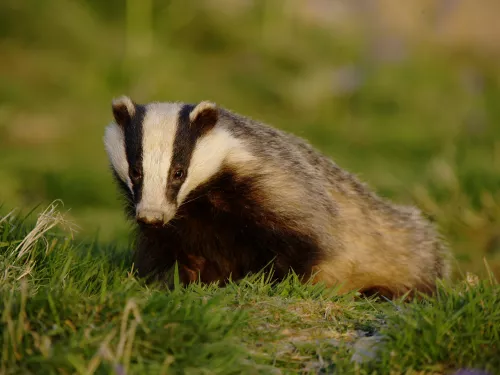
Badgers are the UK’s largest land predator and are one of the most well-known British species. They are famed for their black and white stripes and sturdy body, using their strong front paws to dig for food and to perfect their hobbit-like burrows, called ‘setts’.
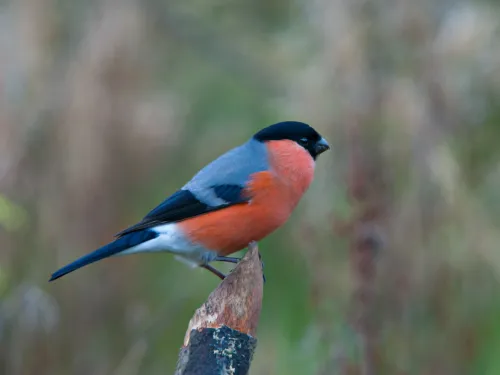
The rose-red breast, large black cap and thick bill make the bullfinch easy to identify. A plump-looking bird of woodlands, hedgerows and orchards, it also frequents gardens.
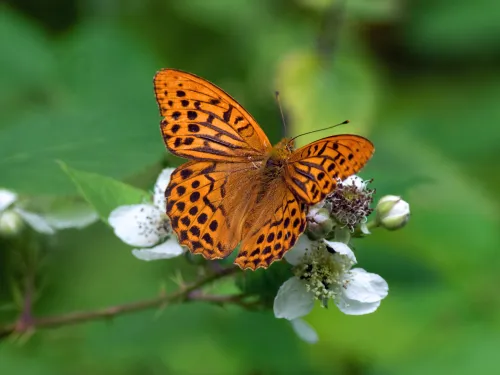
The silver-washed fritillary gets its name from the silver streaks on its underside. It is on the wing in summer, preferring sunny glades in woodlands. Despite declines, its range has spread over recent years.
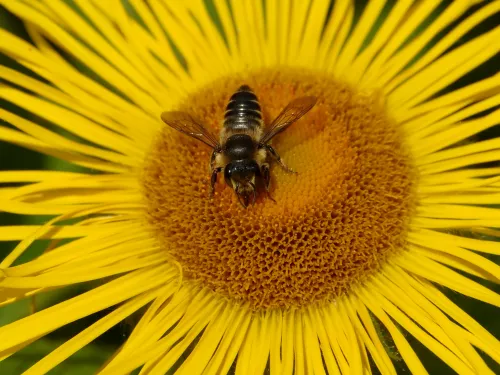
The appearance of semi-circular holes in the leaves of your garden plants is a sure sign that the patchwork leaf-cutter bee has been at work. It is one of a number of leaf-cutter bee species present in the UK.

The common green lacewing is a lime green, delicate insect, with translucent, intricately veined wings. It is common in gardens and parks, where it helps to control aphid pests.
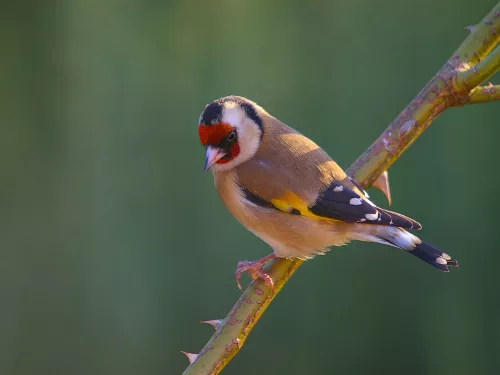
The striking red crown, golden back, and bright yellow wings of the goldfinch make it one of our prettiest garden birds. It happily visits birdtables and feeders across the UK.
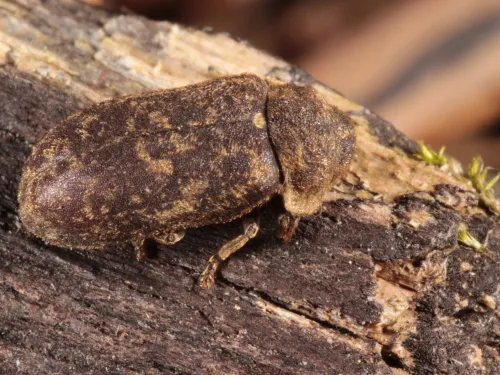
Famed for its tapping in the middle of the night, supposedly heralding tragedy, the Deathwatch beetle is a serious wood-boring pest. In houses, their tunnelling can cause major damage.

The lesser stag beetle may be smaller than its famous cousin, but it is still a large beetle with large jaws. It can be seen in woods, parks and hedgerows during summer, and depends on dead wood.
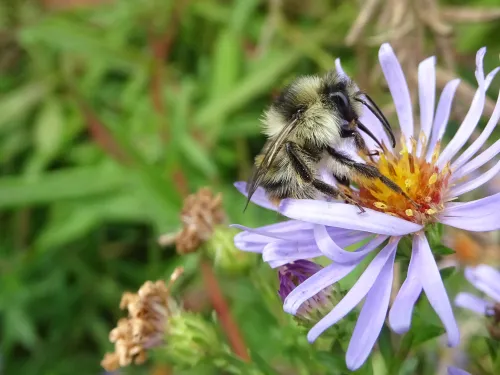
The shrill carder bee can be spotted flying quickly around flowers in unimproved pastures. The queens produce a loud, high-pitched buzz, hence the name. It is declining rapidly and is restricted to just a few locations.
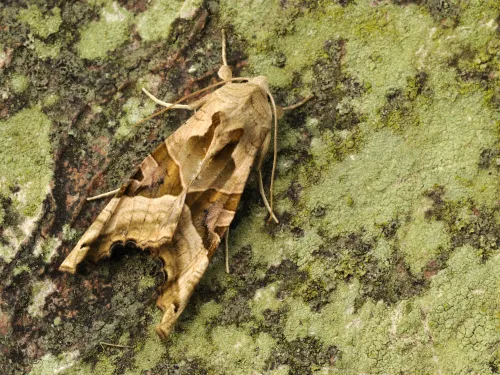
The angle shades can be well-hidden among the leaf litter - its pinky-brown markings and scalloped wings giving it the perfect camouflage. It is on the wing in gardens, woods and hedgerows from May.
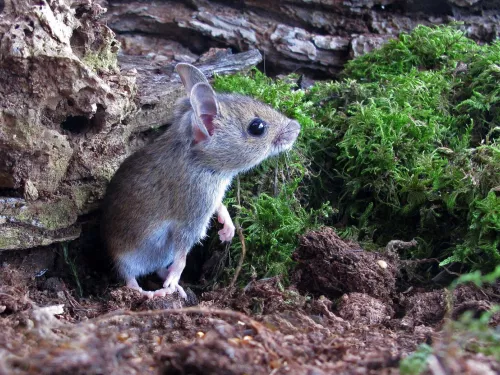
The tiny, brown wood mouse is one of our most common rodents and is very likely to be found in the garden. It is similar to the house mouse, but has larger ears and eyes relative to its size.
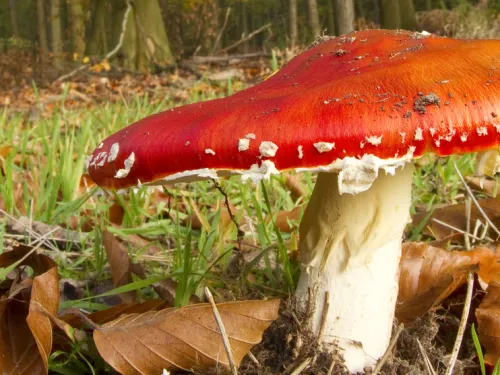
The classic fairy tale toadstool, this red and white fungus is often found beneath birch trees in autumn.
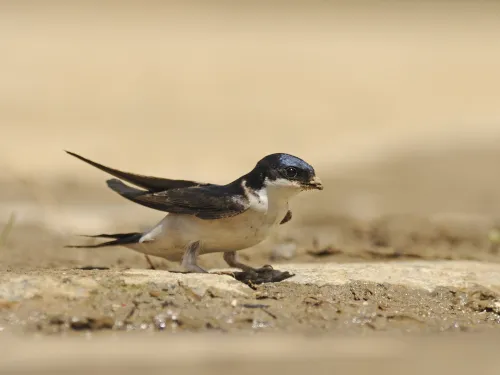
As its name suggests, the house martin can be spotted nesting in the eaves of houses in our towns and villages. Its intricate mud nests take days to build and are often returned to and used in following years.
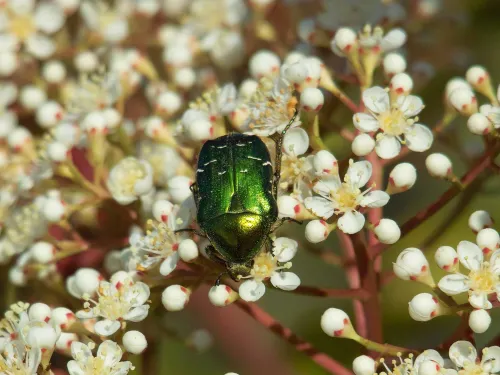
The rose chafer can be spotted on garden flowers, as well as in grassland, woodland edges and scrub.
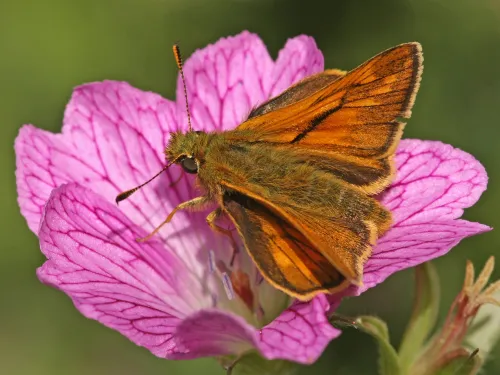
As its name suggests, the large skipper is bigger than the similar-looking small skipper! It can be seen in summer, resting on the long grass of grasslands, woodlands, verges and sand dunes.

The all-black rook is a sociable bird, so can be spotted in flocks or nesting colonies, known as 'rookeries'. Unlike the similar carrion crow, it has a grey bill and 'baggy trouser' feathers around its legs.
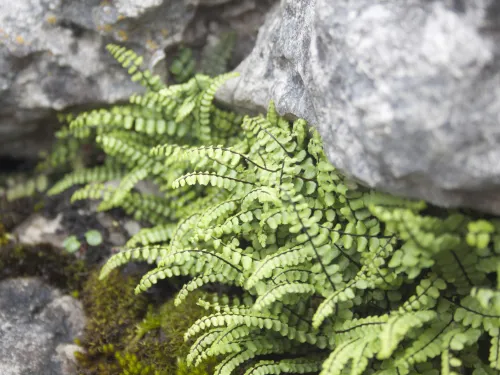
A small, tufted fern, maidenhair spleenwort can be found growing out of crevices between rocks, in walls and on mossy branches across the UK.
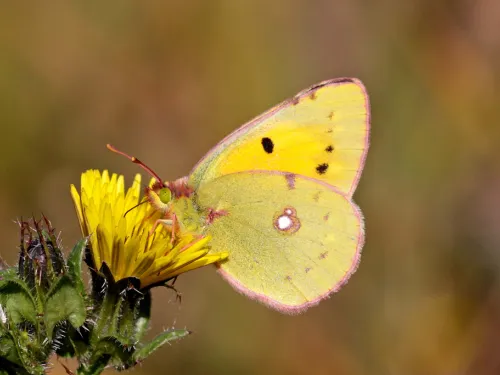
The clouded yellow is a migrant that arrives here from May onwards. Usually, only small numbers turn up, but some years see mass migrations. It prefers open habitats, particularly chalk grassland.
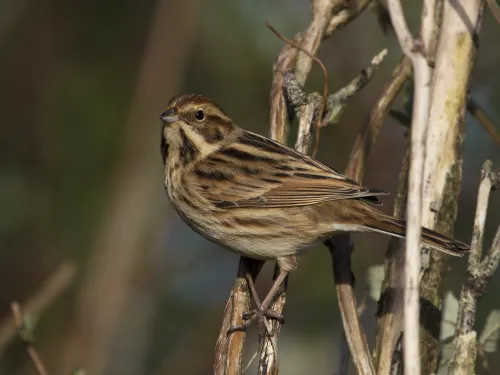
A streaky brown bird, the reed bunting can be found in wetlands, reedbeds and on farmland across the UK. Males sport black heads and a white 'moustache'.
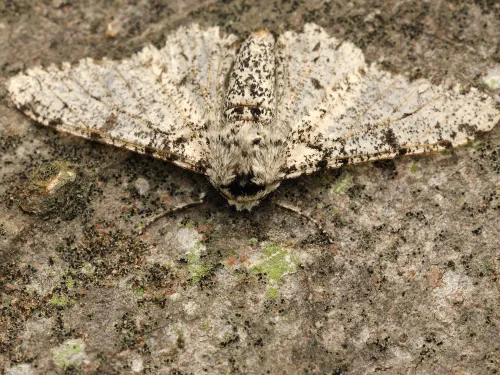
The peppered moth is renowned for its markings that have evolved to camouflage it against lichen in the countryside and soot in the city. It can be seen in gardens, woods and parks, and along hedgerows.

The rhinoceros beetle lives up to its name by sporting a distinctive 'horn' on the males' head. This glossy, blue-black beetle can be found in woods, parks and hedgerows, and depends on dead wood.

The scorpion fly, as its name suggests, has a curved 'tail' that looks like a sting. It is, in fact, the males' claspers for mating. It is yellow and black, with a long 'beak'. Look for it in gardens and woods.
